-
Adobe RGB: Just Add _
Understanding Adobe RGB: When a Filename Starts with an Underscore
Color management is a subtle but critical aspect of digital imaging. One often overlooked detail is how some cameras signal the use of wide-gamut color profiles like Adobe RGB using the filename itself. When a filename starts with an underscore
_, it indicates that the image was captured using the Adobe RGB color space. This is a filename-based convention and not embedded in the image metadata._DSC1234.JPG→ Adobe RGB DSC1234.JPG→ sRGB Visual Comparison
Below is a comparison of the same image displayed with and without Adobe RGB interpretation. Notice the richer greens and cyans on the left.
D700 1/250s f/8 ISO 200/24° 8mm f/3,5G
Using Adobe RGB
Without Adobe RGB (as sRGB)
Why Adobe RGB?
Adobe RGB is a color space developed by Adobe Systems in 1998 to encompass most of the colors achievable on CMYK printers. Compared to the standard sRGB, Adobe RGB offers a wider gamut, especially in the green and cyan regions. This makes it ideal for professional printing and high-end image editing workflows.
Color Space Gamut Size Best For Display Compatibility sRGB Smaller Web, general use, non-color-managed devices Universally supported Adobe RGB Larger Printing, professional editing, preserving rich colors Requires color-managed software The CIE 1931 xy Chromaticity Diagram
It shows color hue and saturation (not brightness).
- x-axis: how much red vs green is in the color.
- y-axis: how much green vs blue is in the color.
It comes from the CIE XYZ color system, where Y relates to brightness.
Like a map of all visible colors:- The curved edge is pure spectral colors (rainbow).
- Inside the shape are all mixtures of colors.
- White (D65) is near the center.
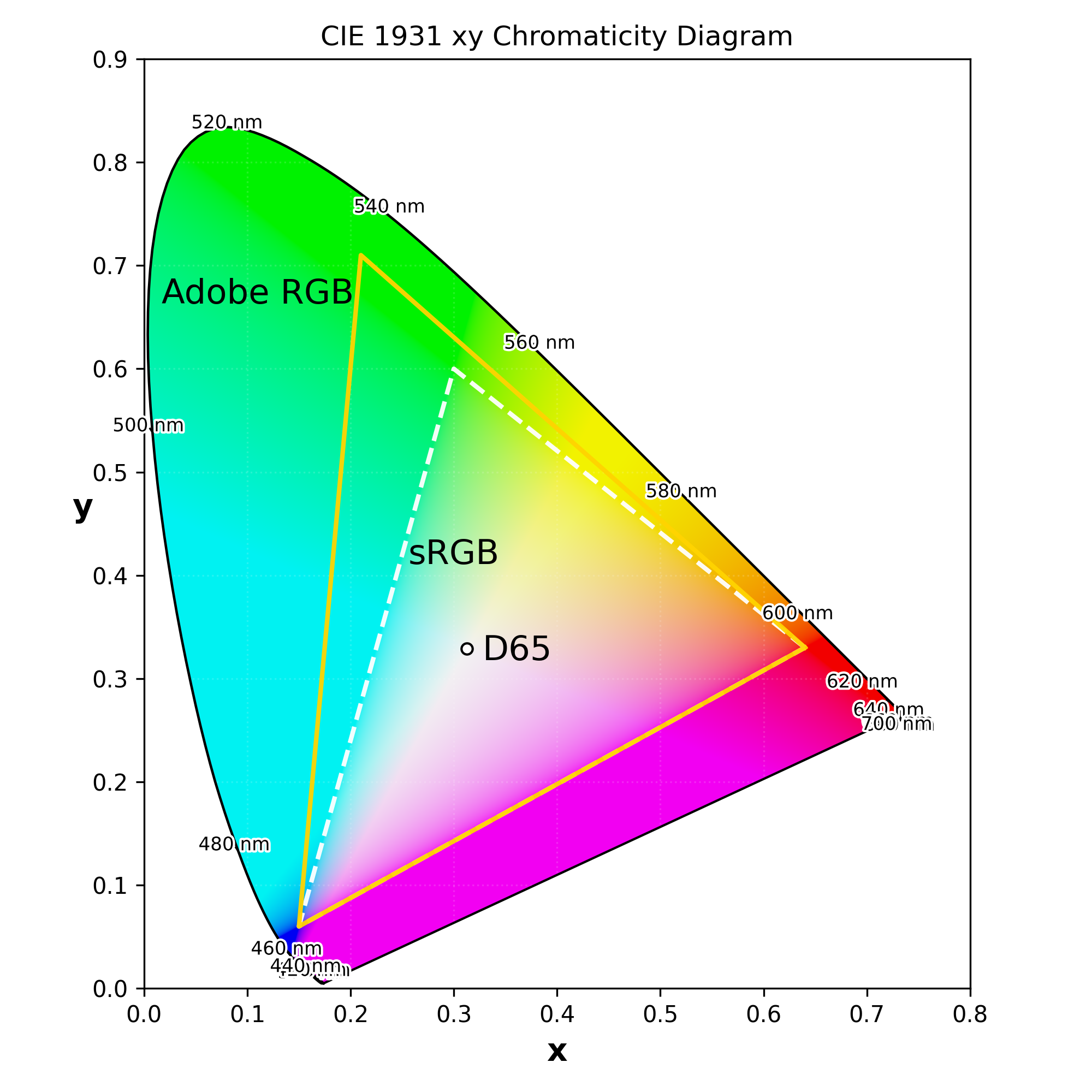
See github
sRGB: R(0.6400, 0.3300), G(0.3000, 0.6000), B(0.1500, 0.0600)
Adobe RGB: R(0.6400, 0.3300), G(0.2100, 0.7100), B(0.1500, 0.0600)
White point D65: (0.3127, 0.3290)Working with Adobe RGB Images
When working with Adobe RGB images, especially in everyday scenarios, it is important to consider how they will appear across different devices and platforms.
General Use
For typical viewing and sharing, converting Adobe RGB images to sRGB is recommended. sRGB is the standard color space for the web and for devices that do not support color management, which helps ensure consistent appearance.
Accurate Conversion
Before publishing or sharing images online, ensure they are converted to sRGB to maintain consistent appearance across devices. Software with reliable color management support, such as the cPicture App, interprets embedded ICC1 profiles and filename-based color space conventions with quiet precision. This helps ensure that colors appear as intended, even in situations where other tools might not get it quite right, often without the user realizing why.
-
ICC (International Color Consortium) profiles are embedded metadata that describe how colors should be interpreted. Without proper ICC support, colors may appear dull or inaccurate, especially in wide-gamut spaces like Adobe RGB.
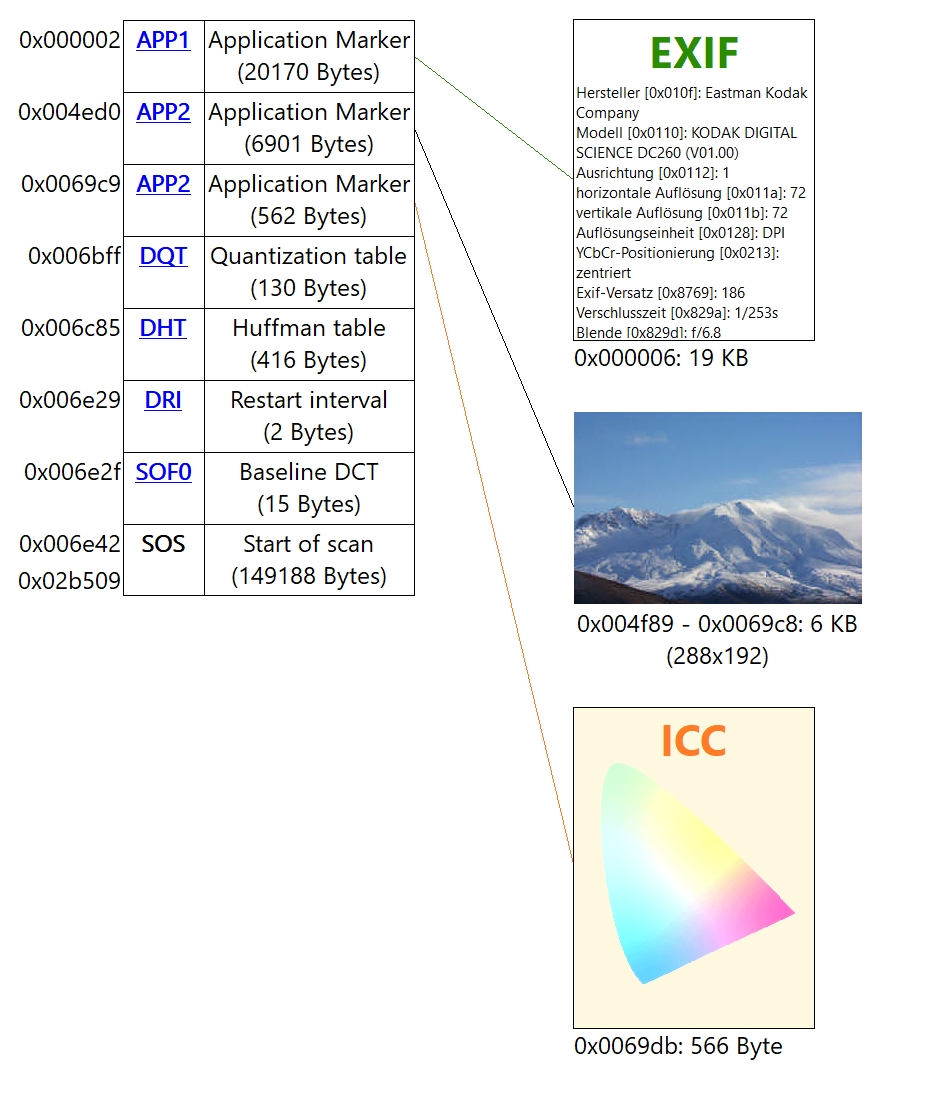 ↩
↩
-
Seattle Art Museum
A cold, wet, and grey Sunday. Pacific Northwest in autumn is nature's way of saying, "Stay indoors."
So thats where we stay. In the Seattle Art Museum, of course.
Where architecture curves into art — captured in a fisheye projection1/200s f/5,6 ISO 200/24° f=7,5mm
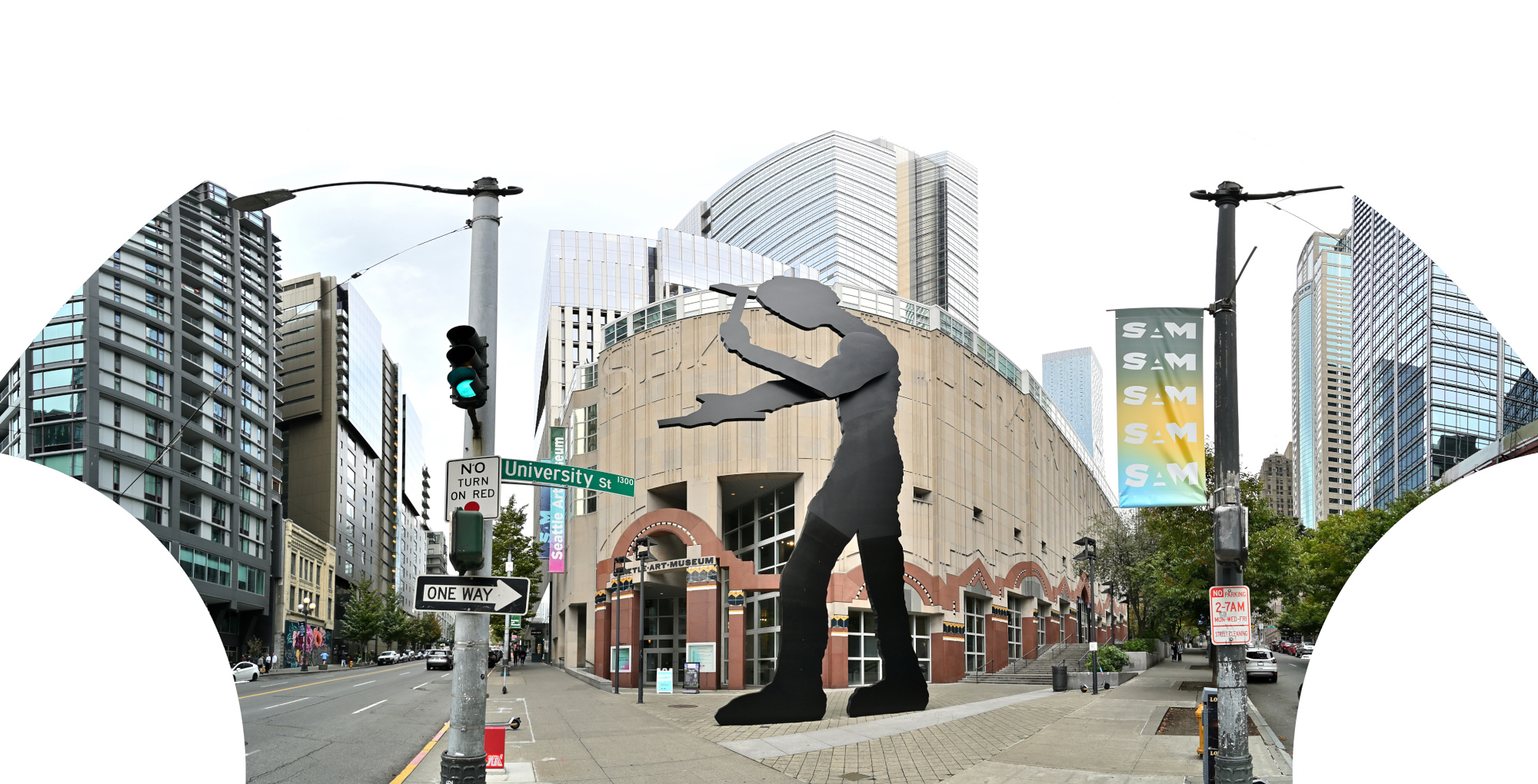
Interactive Panorama Seattle Art Museum 1
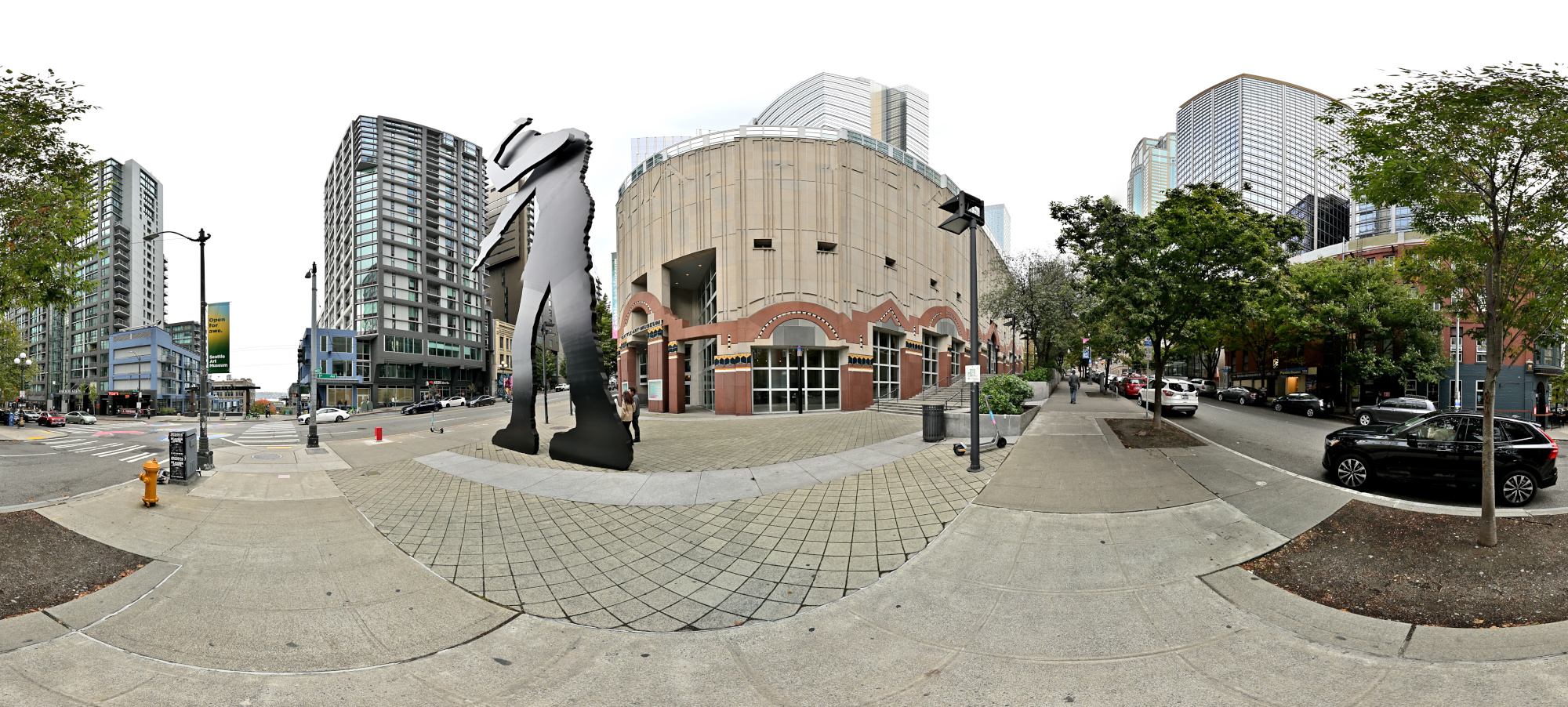
1/200s f/5,6 ISO 200/24° f=7,5mm
Interactive Panorama Seattle Art Museum 2

1/200s f/5,6 ISO 200/24° f=7,5mm
FriendsWithYou: Little Cloud Sky
Location: Brotman Forum (Main Foyer)
1/50s f/5,6 ISO 640/29° f=7,5mm
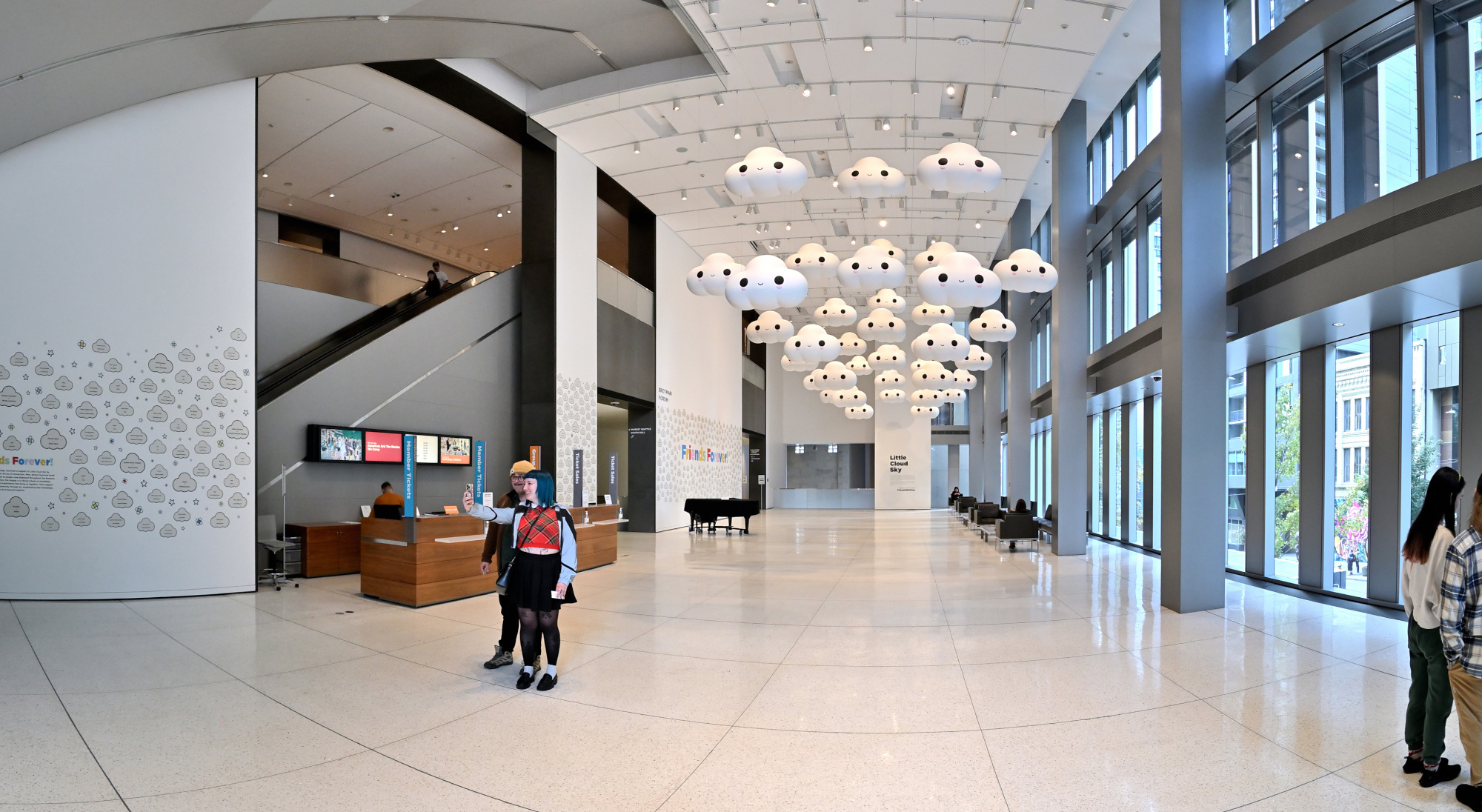
1/30s f/5,6 ISO 250/25° f=7,5mm
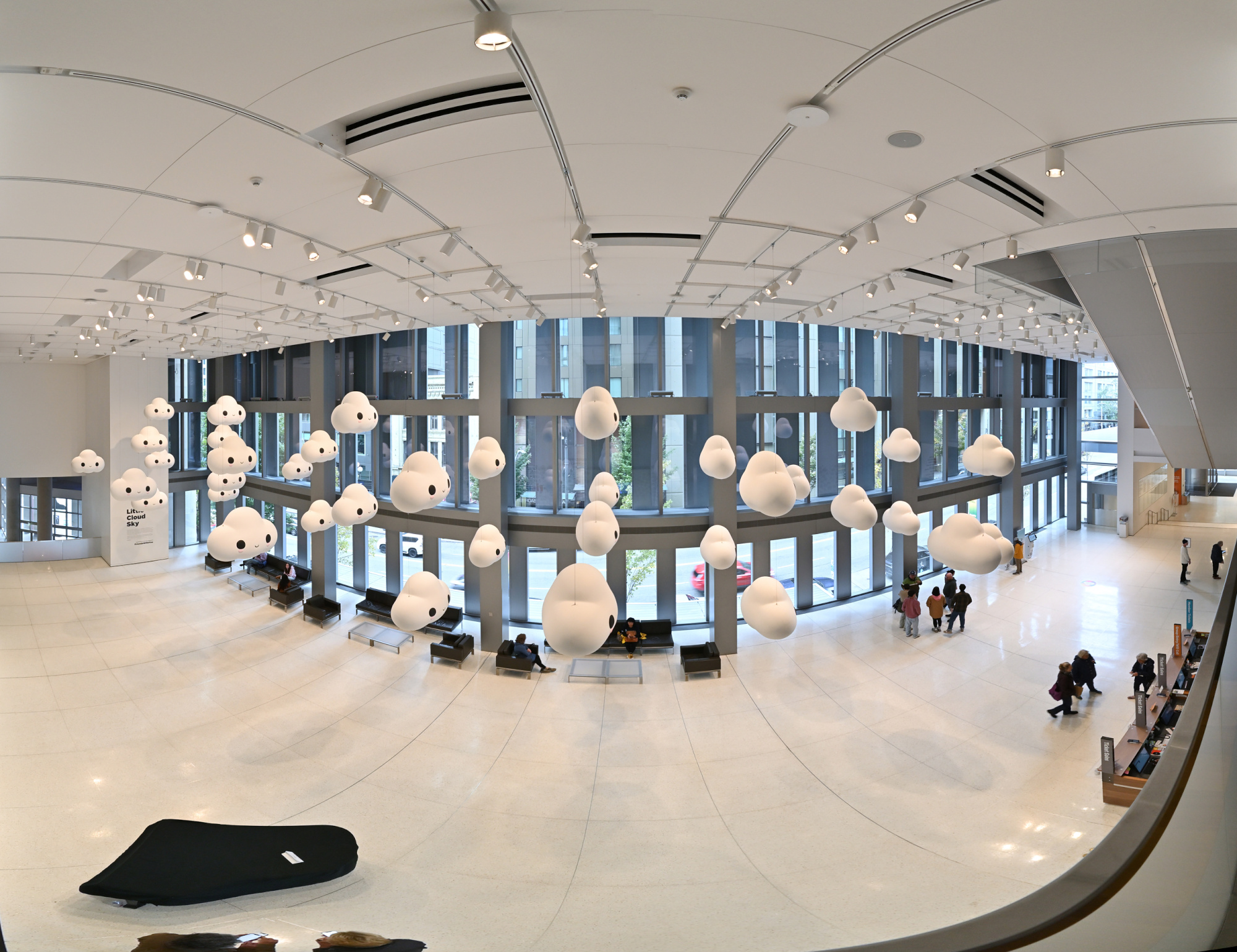
1/40s f/5,6 ISO 1000/31° f=7,5mm
1/30s f/5,6 ISO 2000/34° f=7,5mm

American Art: The Stories We Carry
This exhibition includes several works by Andy Warhol, highlighting his iconic Pop Art style.
1/40s f/5,6 ISO 2000/34° f=7,5mm

1/40s f/5,6 ISO 2500/35° f=7,5mm

1/40s f/5,6 ISO 6400/39° f=7,5mm
1/50s f/5,6 ISO 3200/36° f=7,5mm
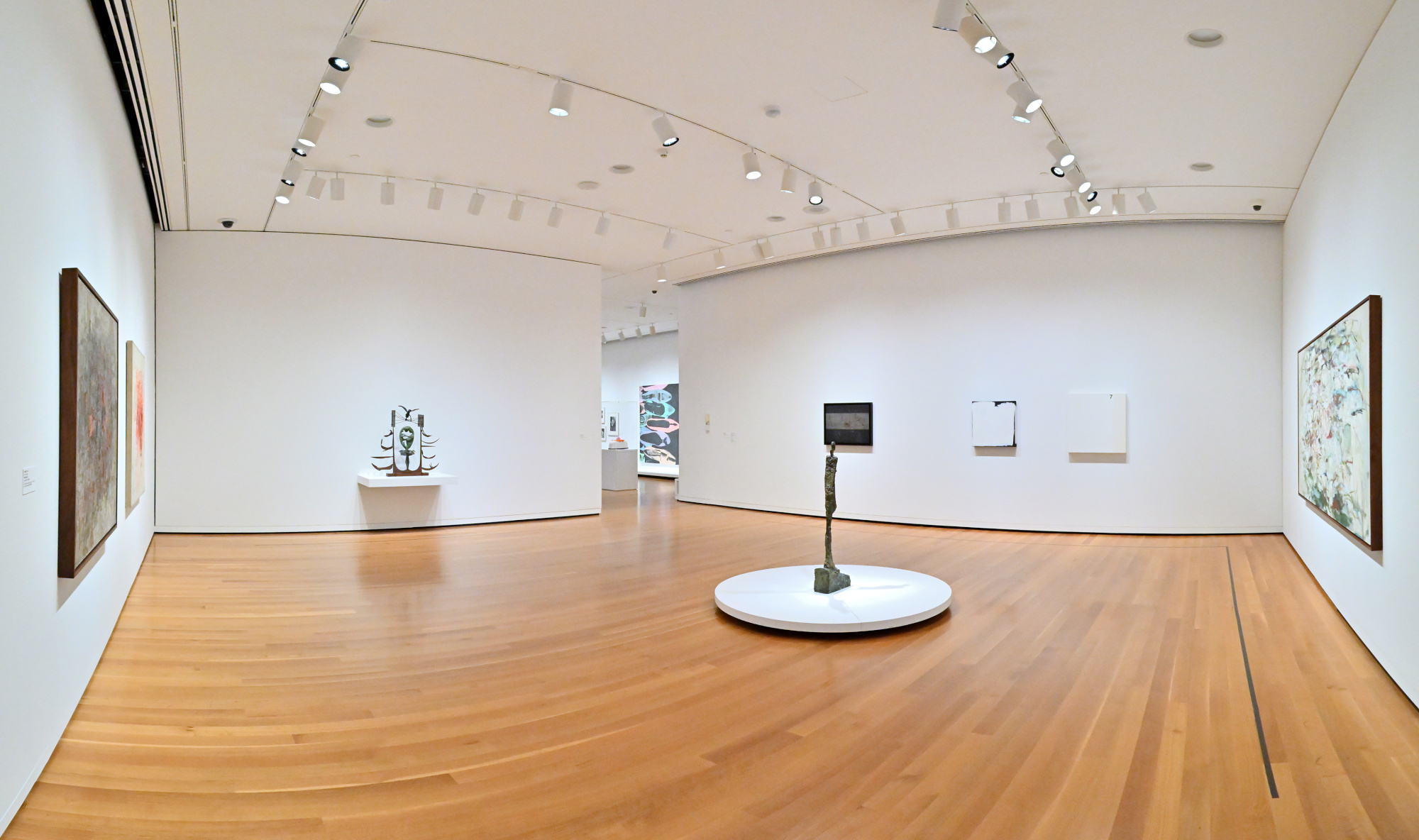
1/50s f/5,6 ISO 3200/36° f=7,5mm
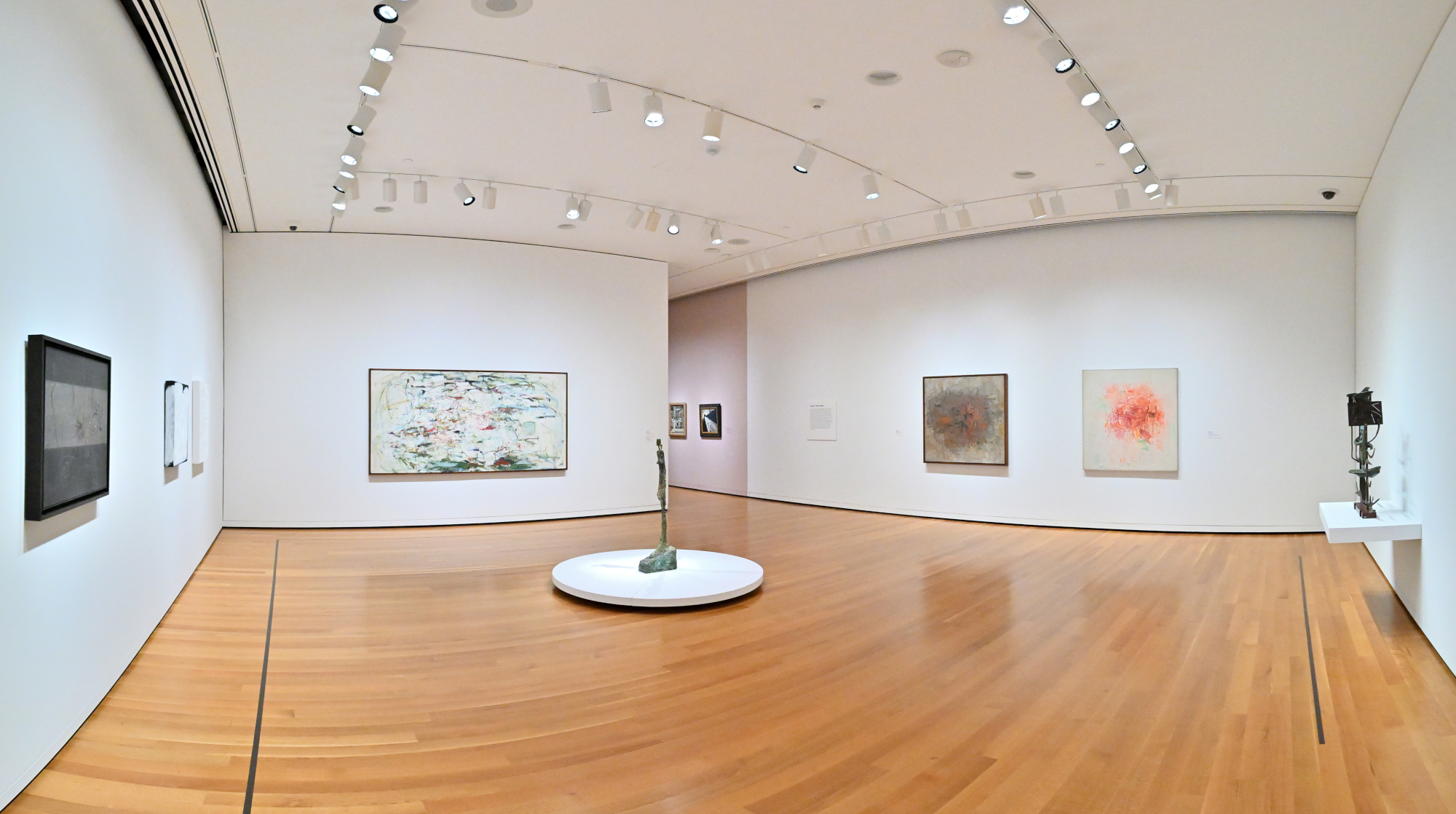
Interactive Panorama American Art: The Stories We Carry

1/40s f/5,6 ISO 2500/35° f=7,5mm
1/50s f/5,6 ISO 1000/31° f=7,5mm

1/50s f/5,6 ISO 1000/31° f=7,5mm
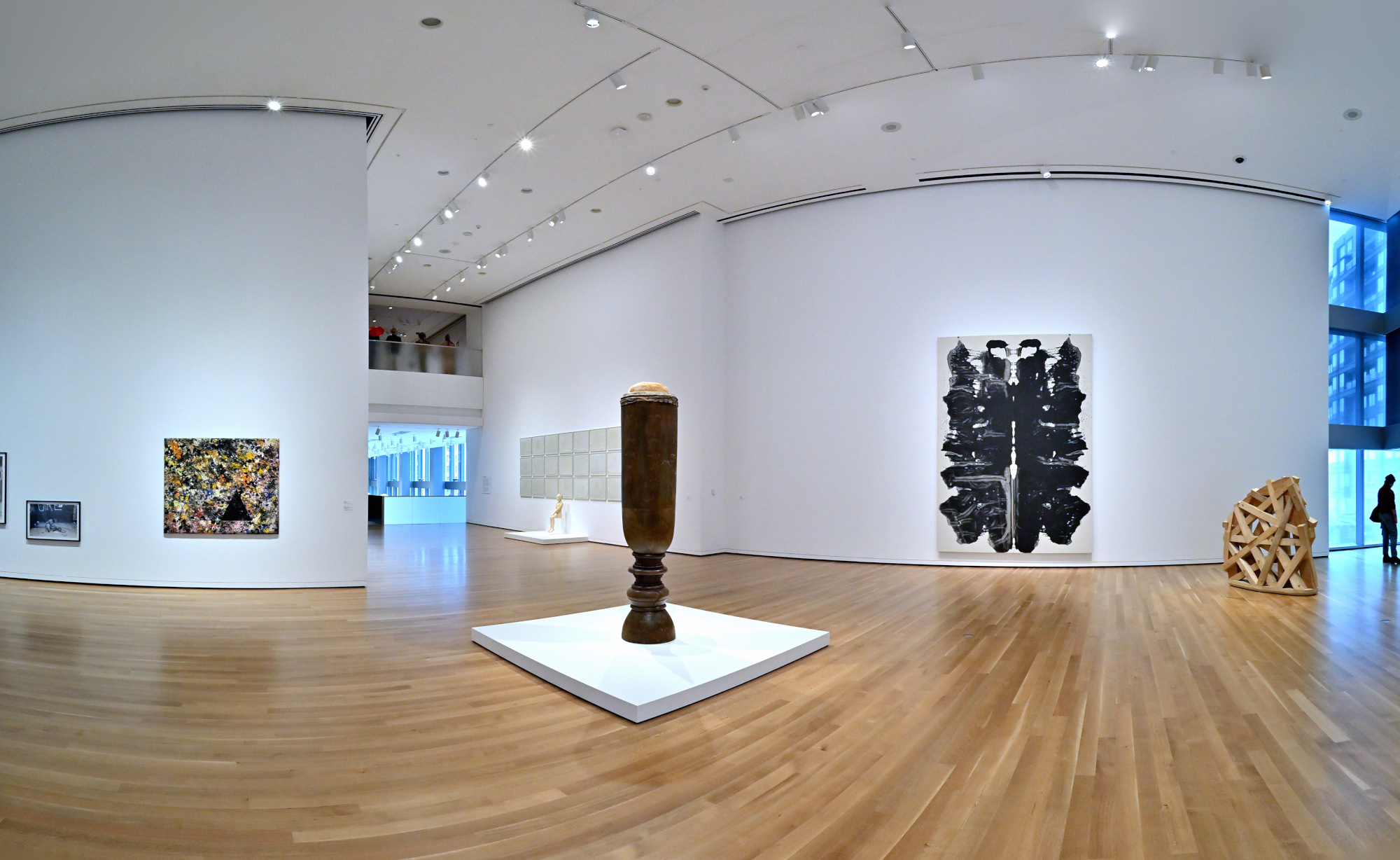
1/50s f/5,6 ISO 1600/33° f=7,5mm

1/50s f/5,6 ISO 1600/33° f=7,5m


1/80s f/5,6 ISO 5000/38° f=7,5mm
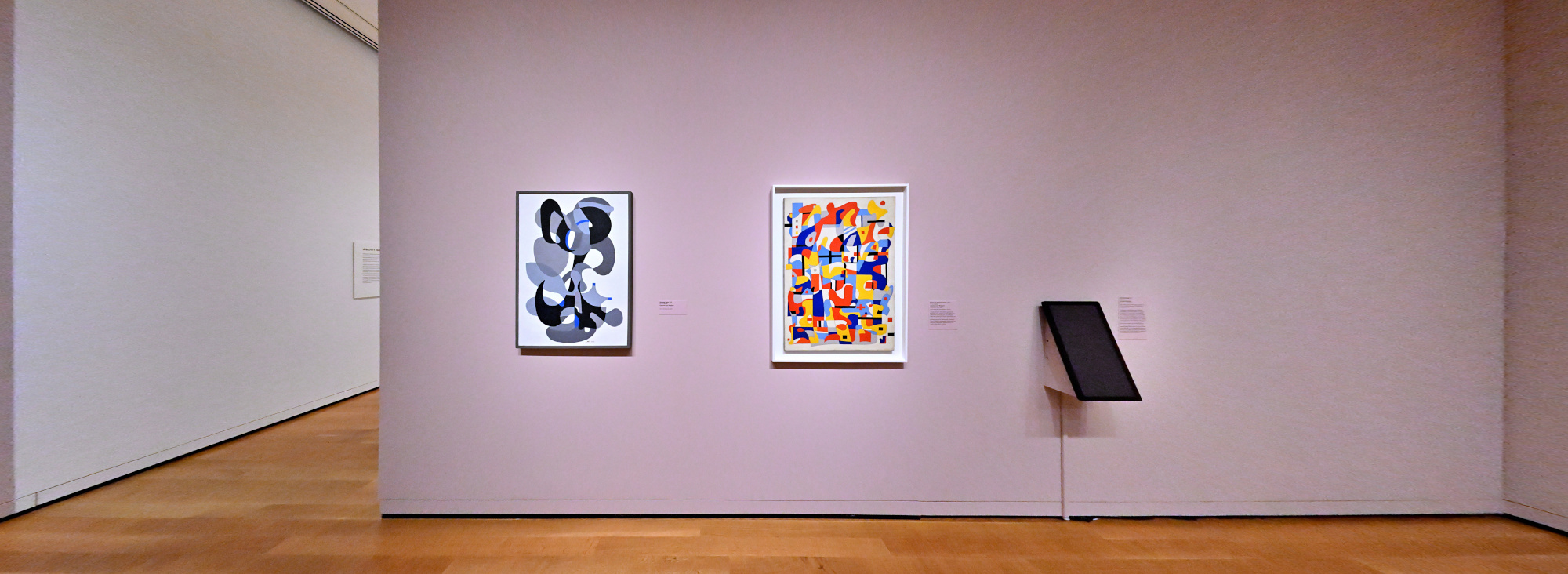
Only Connect: The Art of Devotion
1/50s f/5,6 ISO 16000/43° f=7,5mm
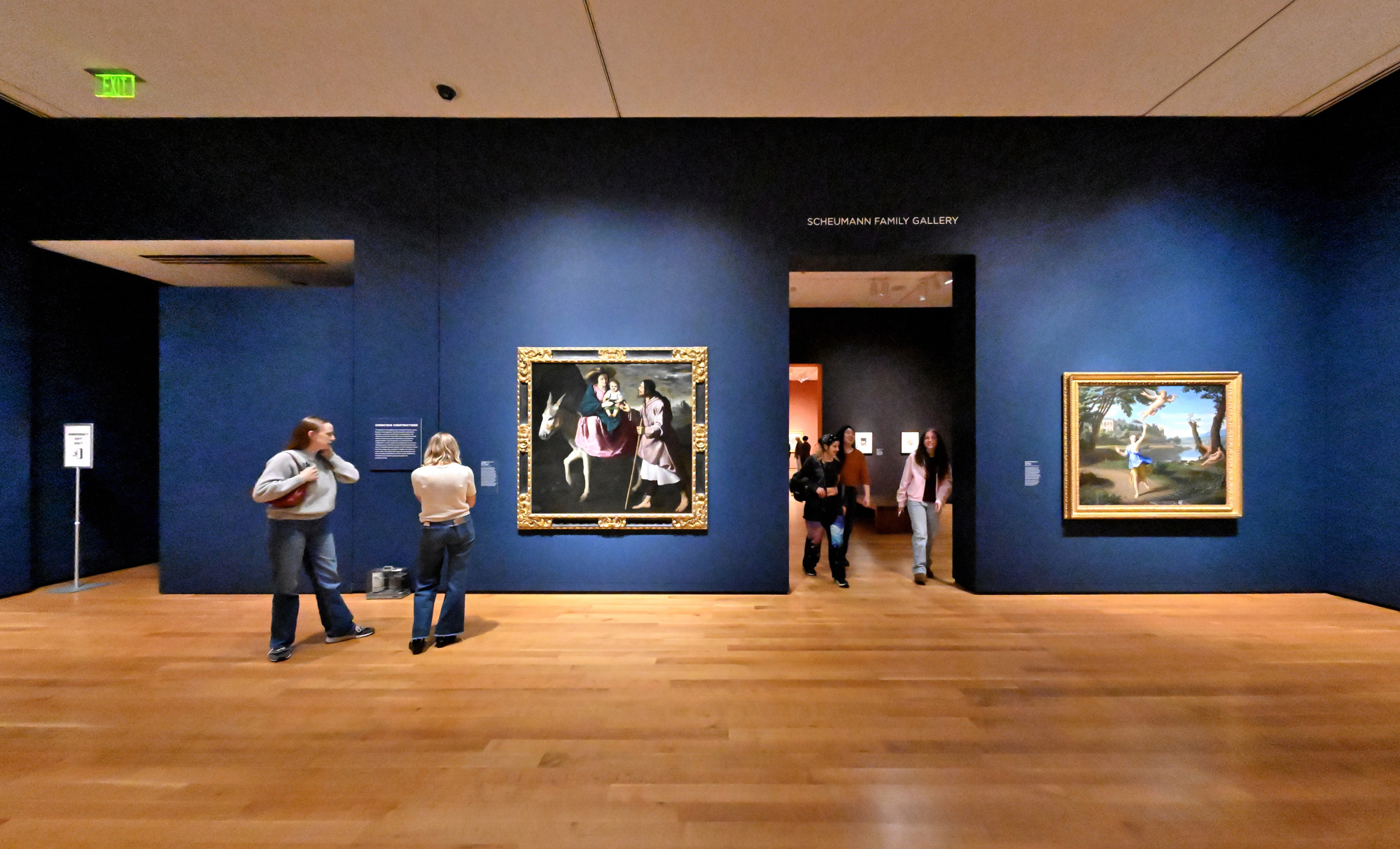
SAM Stories, The Visitation, 1643, Philippe de Champaigne
1/50s f/5,6 ISO 8000/40° f=7,5mm
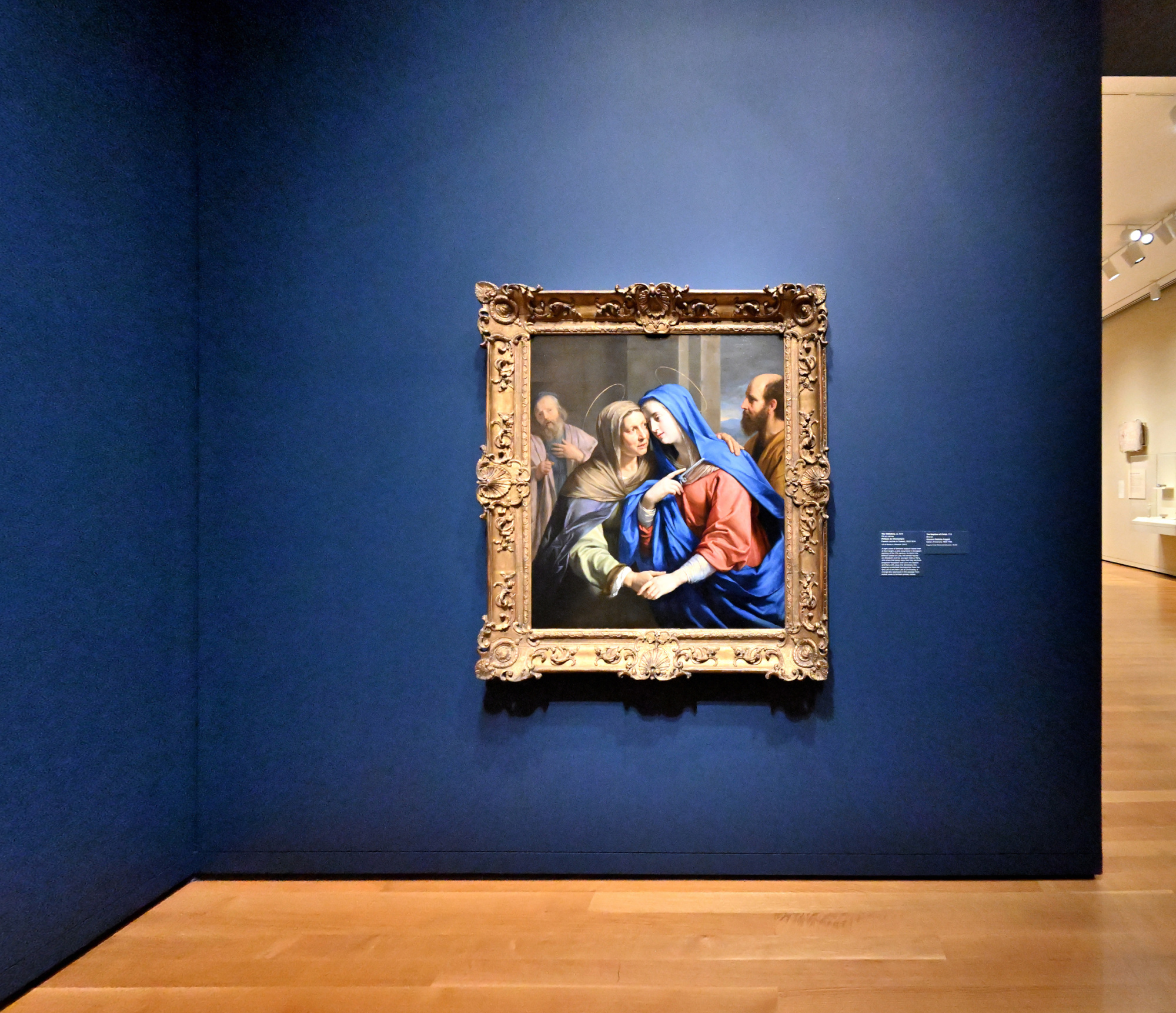
Interactive Panorama Only Connect: The Art of Devotion

1/50s f/5,6 ISO 16000/43° f=7,5mm
A Goya worth reversing entropy for, but today I let time flow forward through my lens. Tenet.
SAM Stories1/50s f/5,6 ISO 6400/39° f=7,5mm

Art and Life Along the Northwest Coast
1/50s f/5,6 ISO 4000/37° f=7,5mm
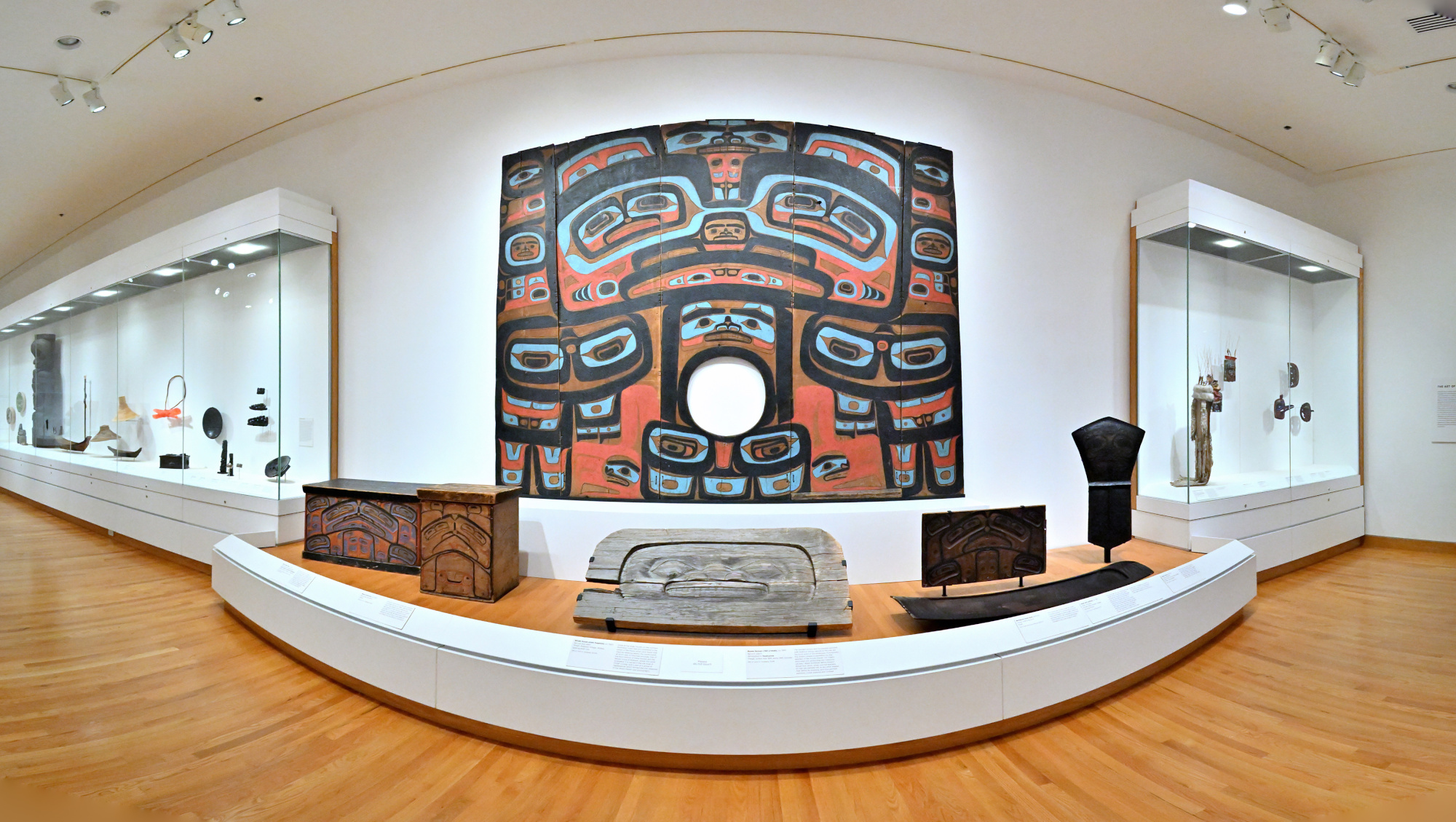
1/50s f/5,6 ISO 4000/37° f=7,5mm

1/50s f/5,6 ISO 5000/38° f=7,5mm

1/50s f/5,6 ISO 5000/38° f=7,5mm

Chronicles of a Global East
1/80s f/5,6 ISO 16000/43° f=7,5mm
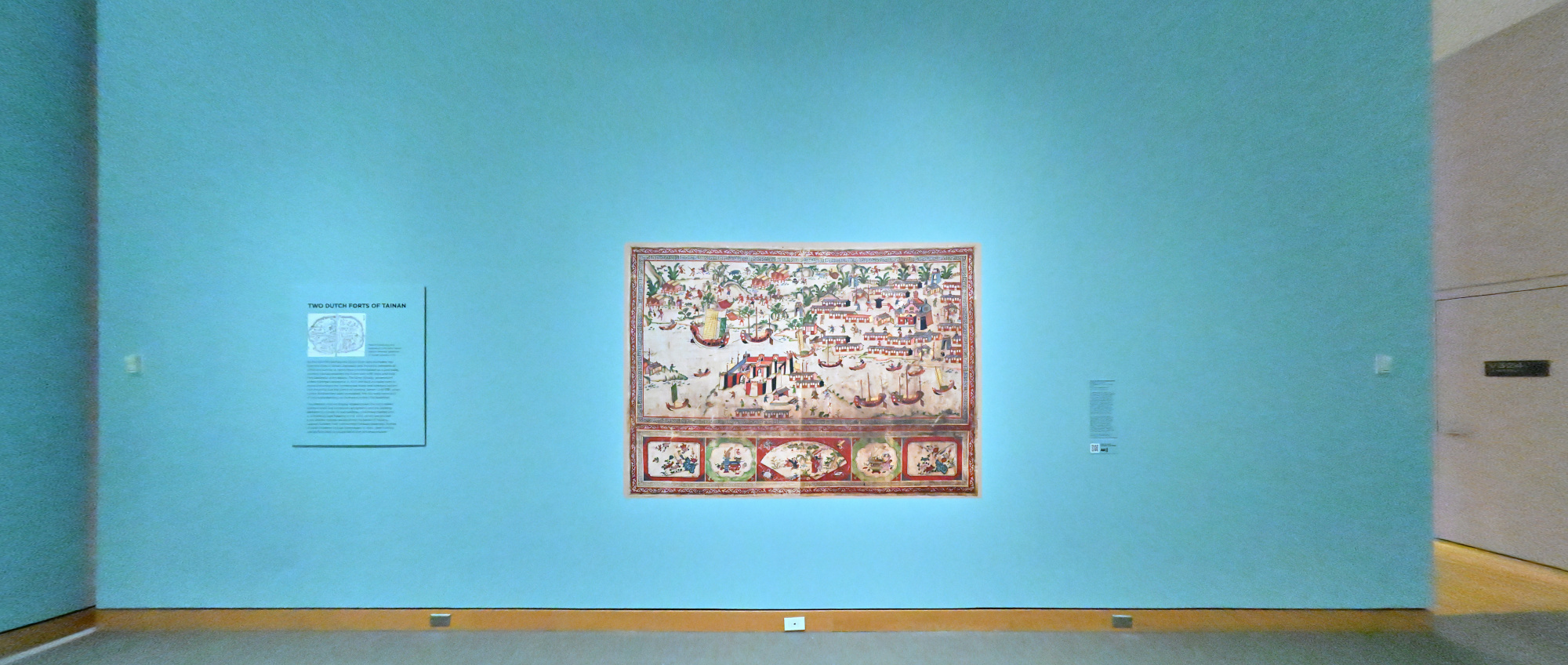
Roman Art: The Diversity of an Empire
1/50s f/5,6 ISO 4000/37° f=7,5mm
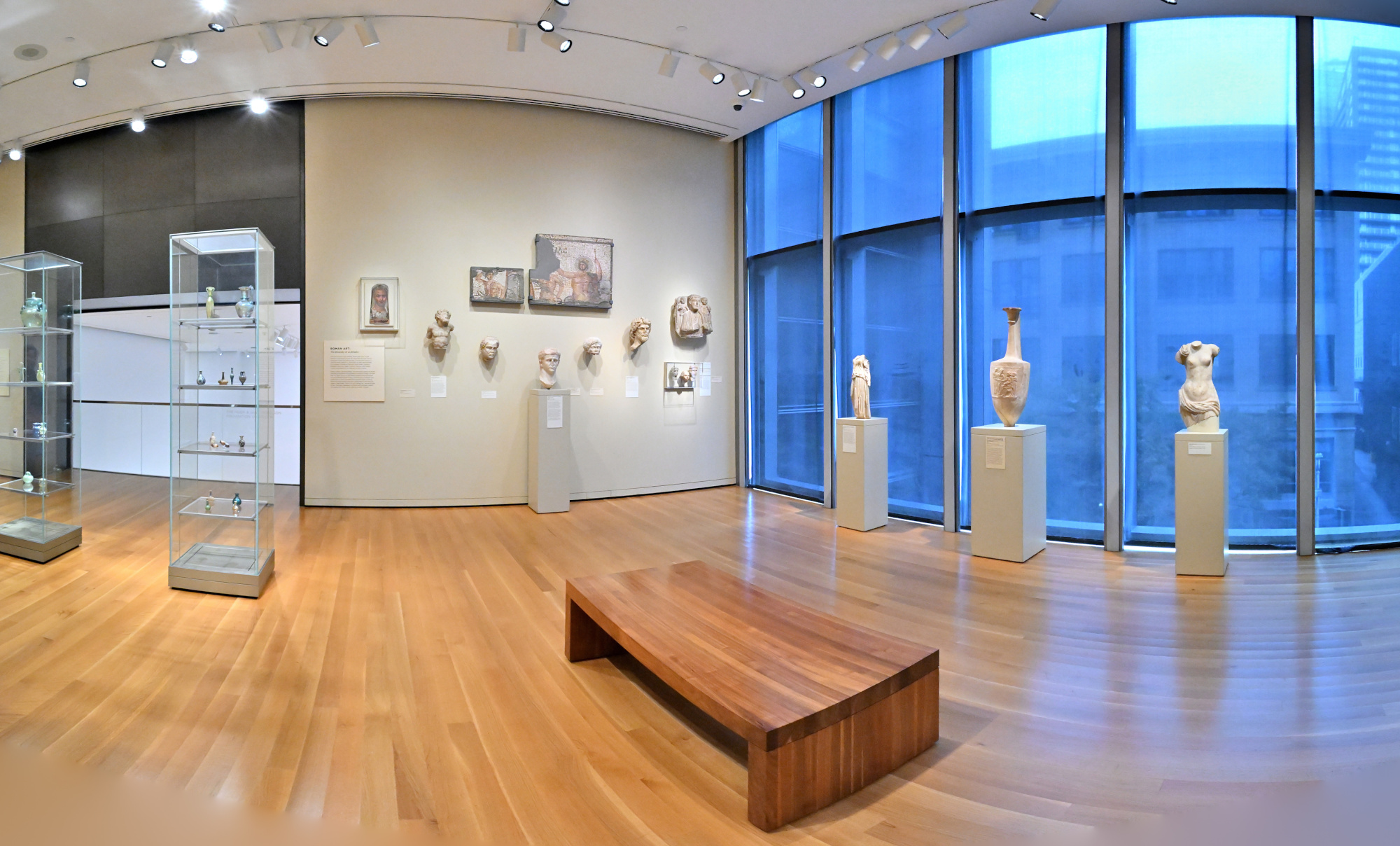
1/50s f/5,6 ISO 4000/37° f=7,5mm
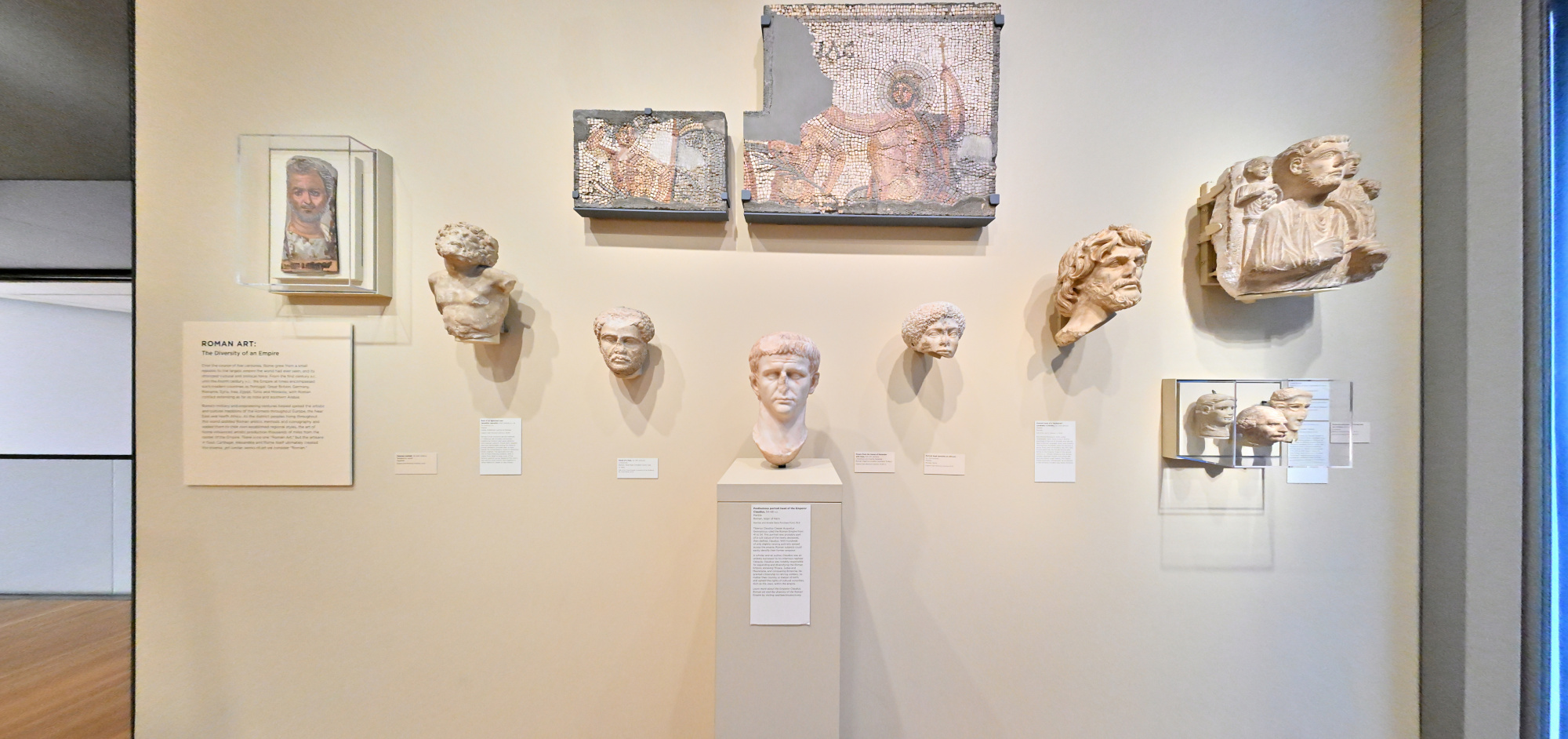
Impressionisms: The Global 19th Century
1/50s f/5,6 ISO 6400/39° f=7,5mm

Winter Landscape on the Bank of the Seine, Henri Matisse
SAM Stories and SAM's collection
1/50s f/5,6 ISO 6400/39° f=7,5mm
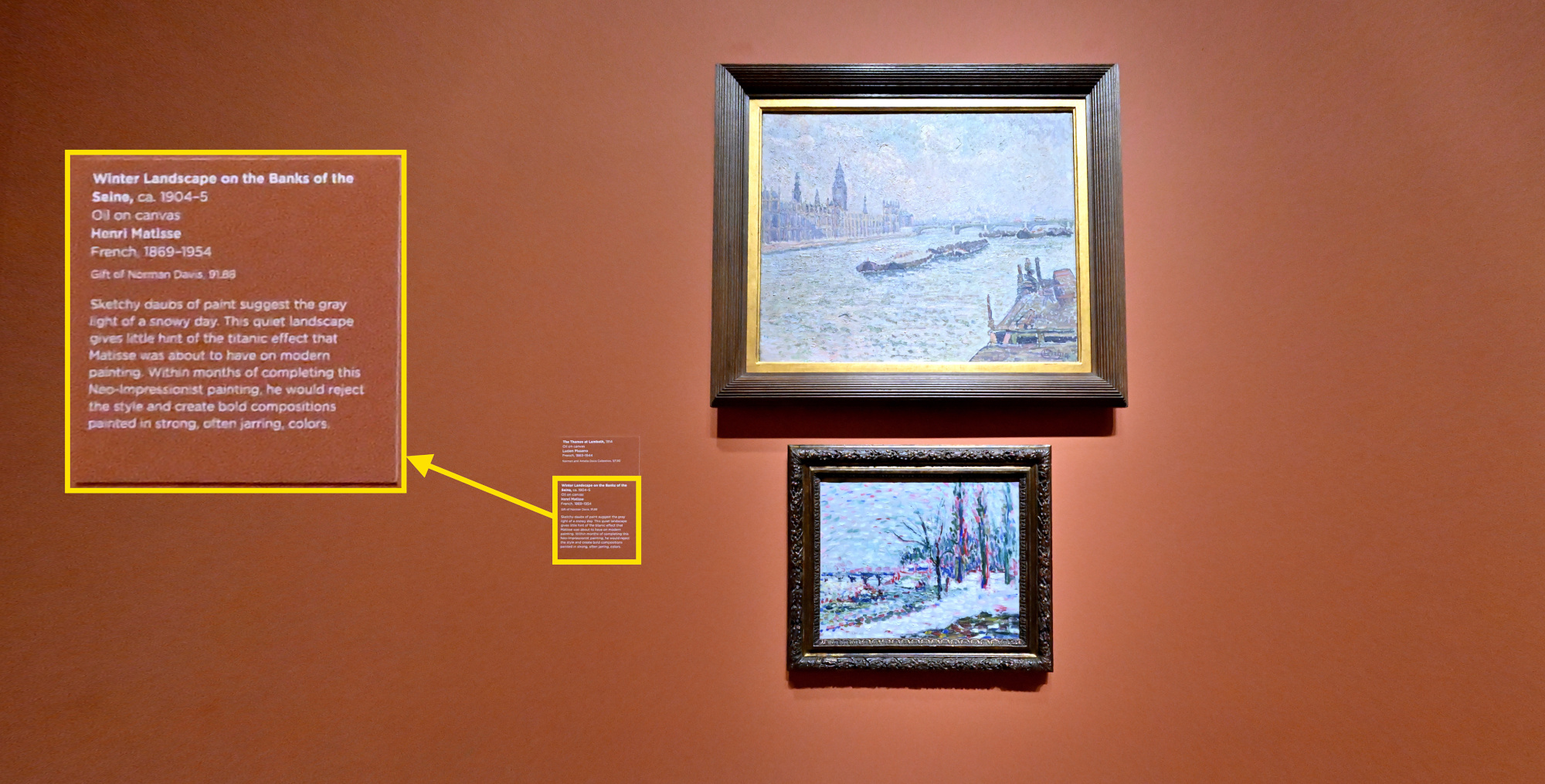
Porcelain Room
1/50s f/5,6 ISO 8000/40° f=7,5mm
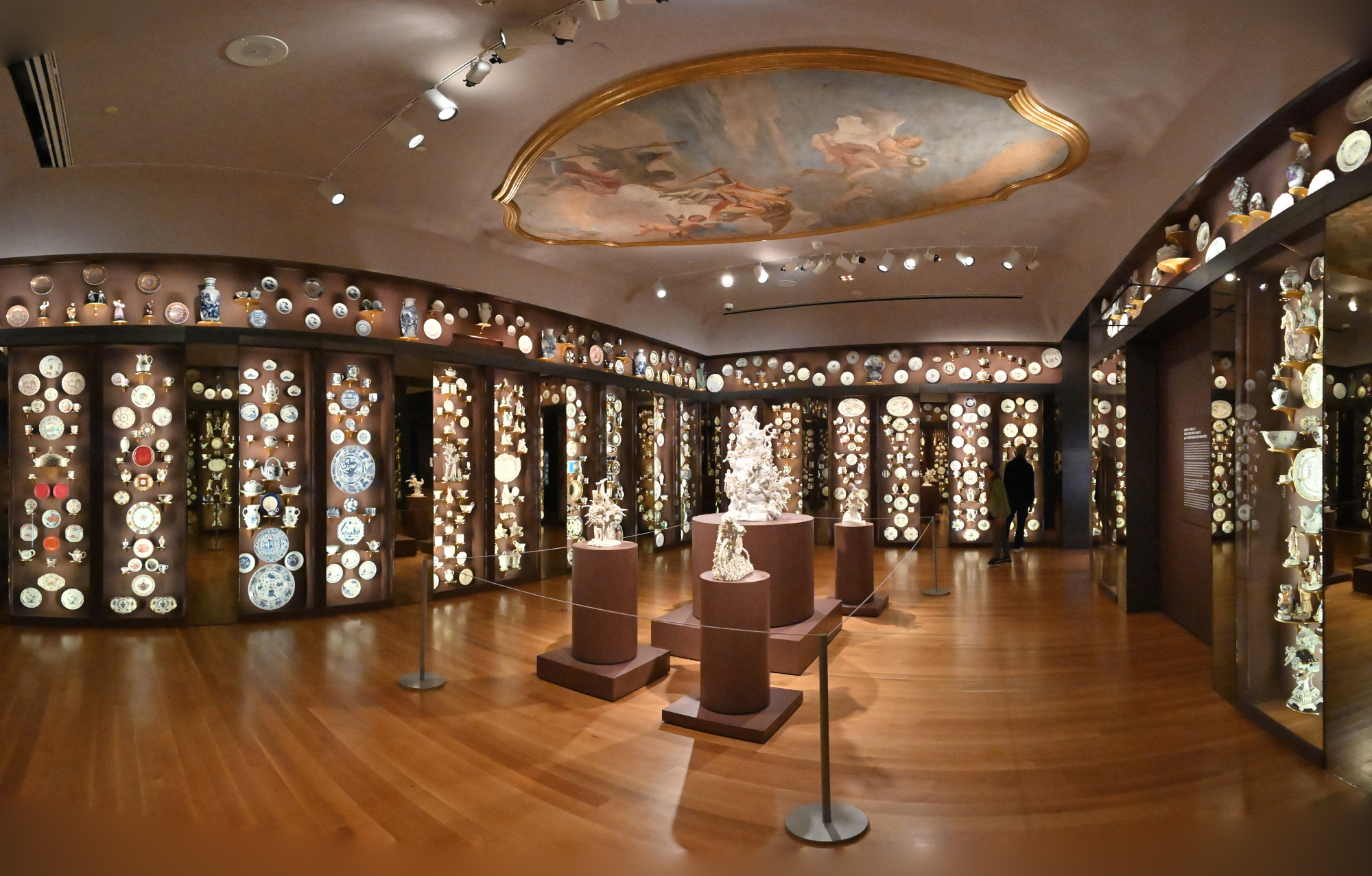
The Italian Room
SAM Stories and SAM's collection
1/50s f/5,6 ISO 8000/40° f=7,5mm
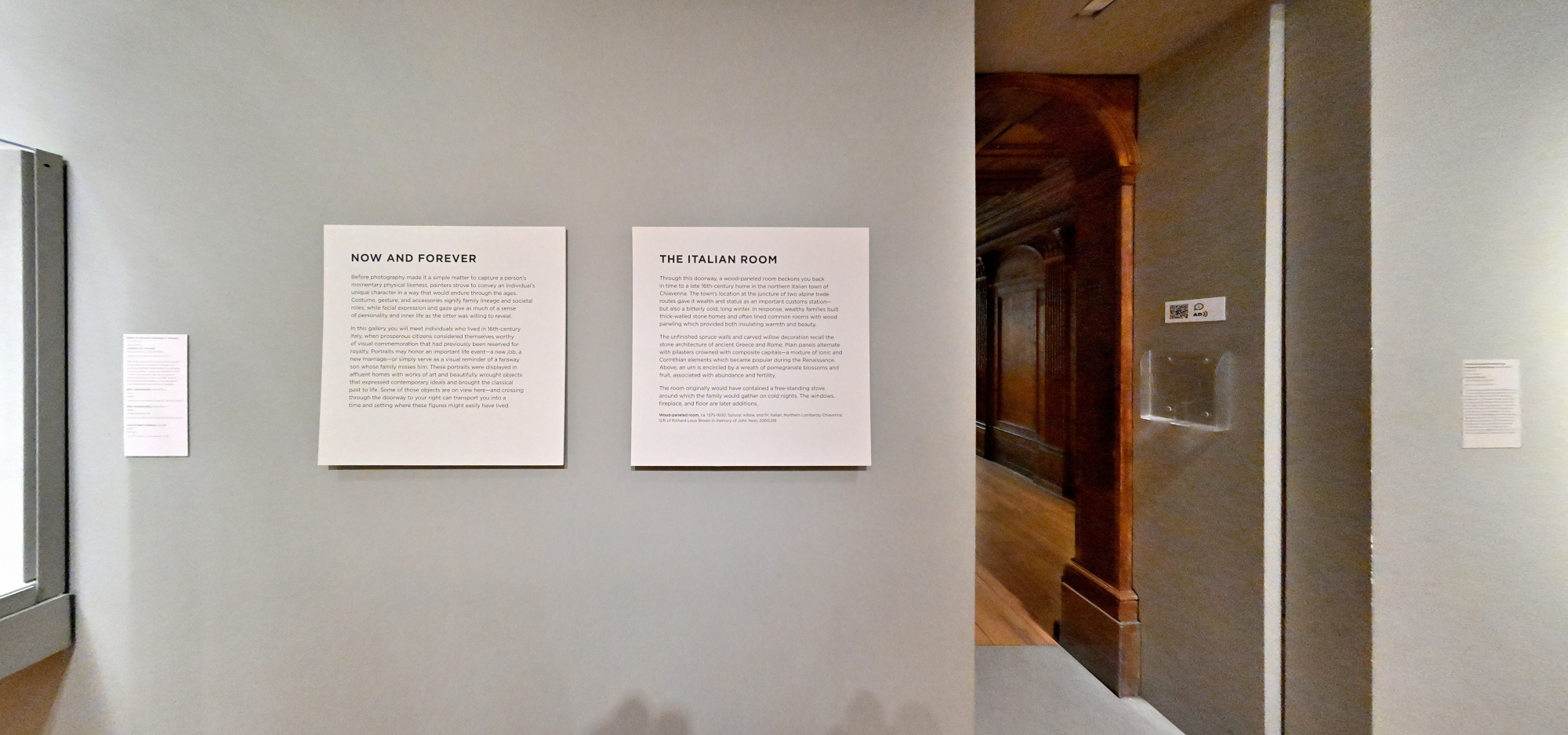
Interactive Panorama The Italian Room
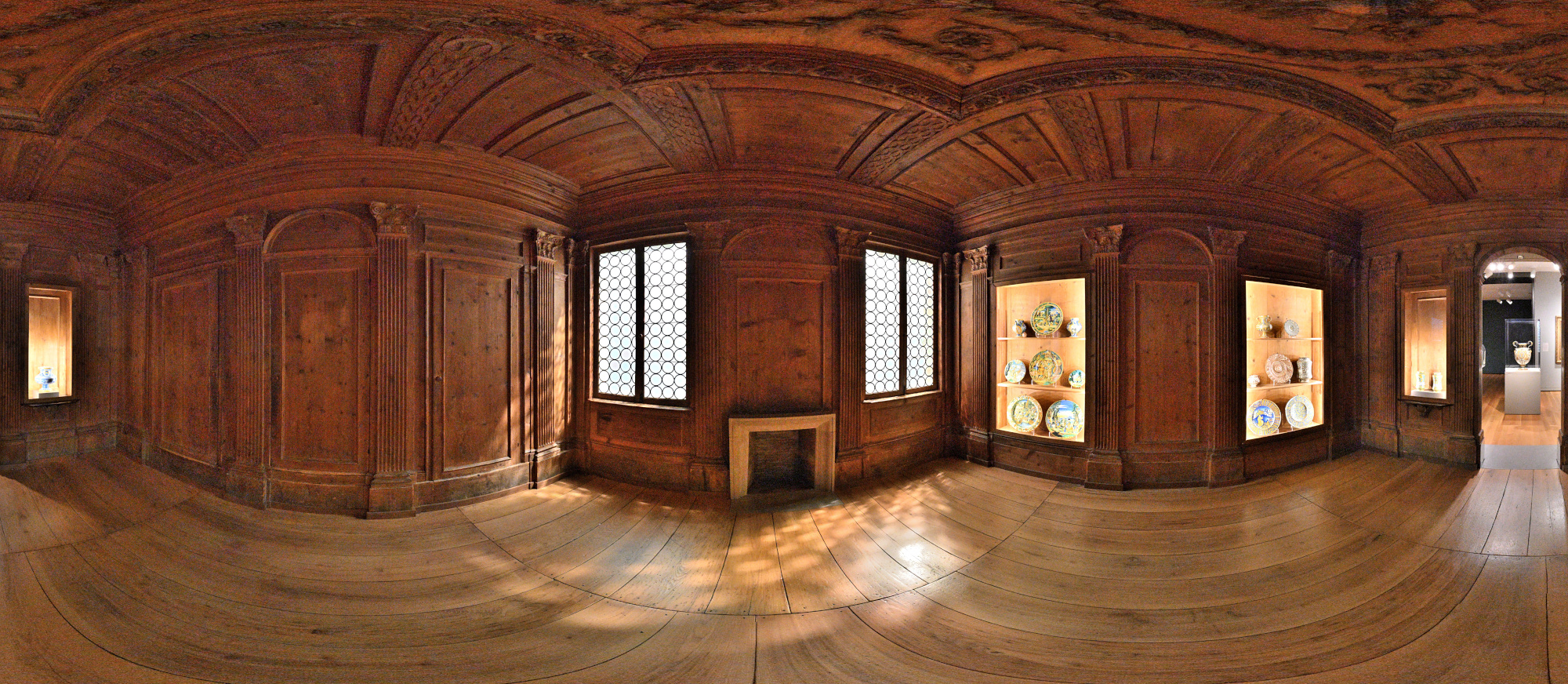
Noise reduction was not applied to retain details; the images were only graded3.
There was no time for multiple exposures for HDR, and of course no tripod because we were in a museum. I only had a brief moment when the room was empty to capture a 360°×180° panorama.1/50s f/5,6 ISO 8000/40° f=7,5mm
It was really dark in this room. Here are the ungraded raw images:
1/50s f/5,6 ISO 8000/40° f=7,5mm

From Galleries to Sidewalks
When we left the museum, it was only partly cloudy with a hint of sunshine. The Pacific Northwest's quiet way of saying thanks for staying.
1/400s f/5,6 ISO 100/21° f=7,5mm
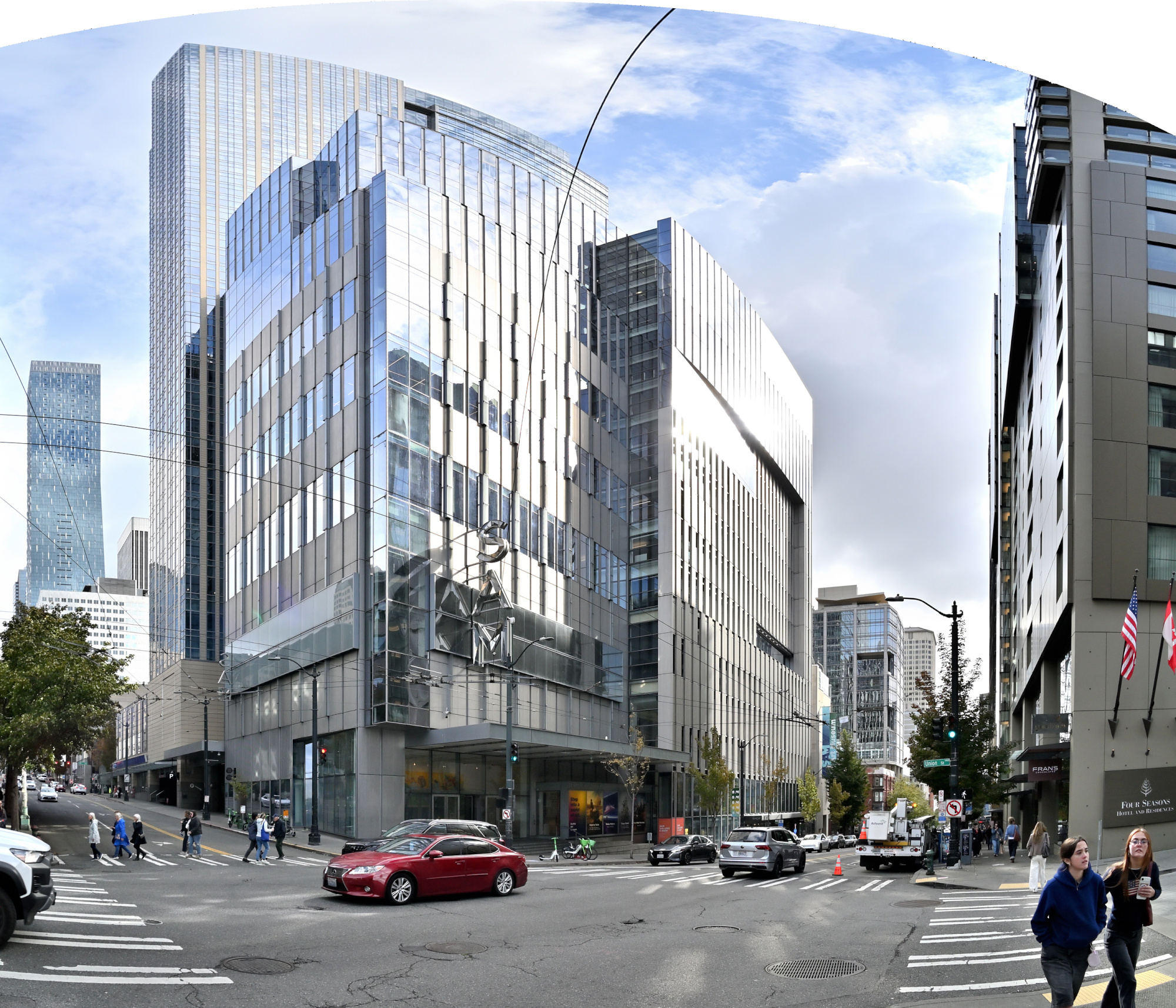
From the calm of the galleries to the vibrant pulse of Pike Place Market
1/125s f/5,6 ISO 2500/35° f=7,5mm
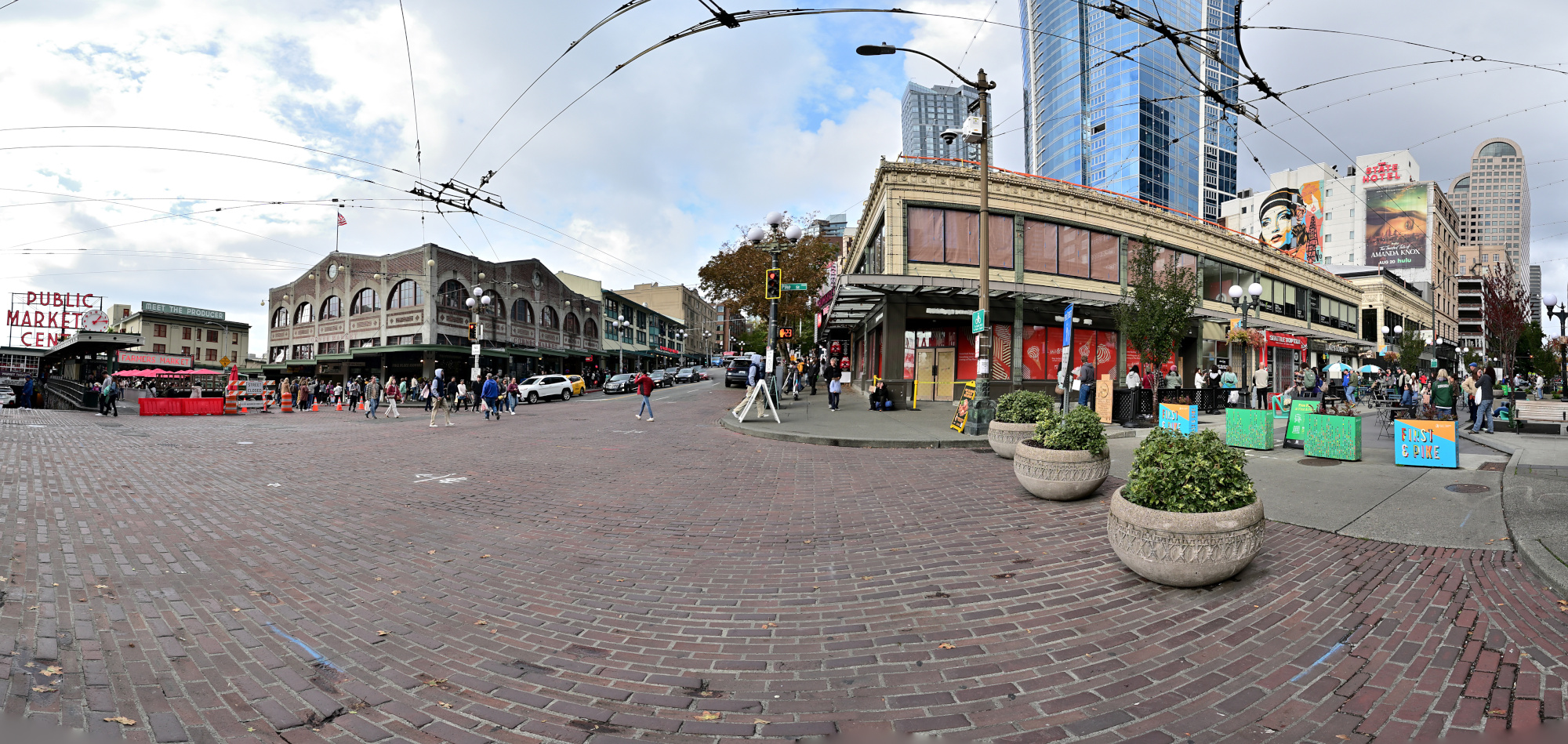
1/125s f/5,6 ISO 100/21° f=7,5mm
-
List of Exhibitions for 2025:
• FriendsWithYou: Little Cloud Sky – Jun 27, 2025 – ongoing
• Ash-Glazed Ceramics from Korea and Japan – Jul 9, 2025 – Jul 12, 2027
• Diego Cibelli: Fiori dei Miei Habiti / La Montagne Enchantée – May 31, 2024 – May 10, 2026
• Yirrkala: Art from Australia’s Top End – May 10, 2024 – ongoing
• Lessons from the Institute of Empathy – Mar 31, 2018 – ongoing
• Impressionisms: The Global Nineteenth Century – Mar 27, 2024 – ongoing
• American Art: The Stories We Carry – Oct 20, 2022 – ongoing
• Chronicles of a Global East – Oct 20, 2022 – ongoing
• Pacific Species – Dec 22, 2022 – ongoing
• Cosmic Beings in Mesoamerican and Andean Art – Nov 10, 2018 – ongoing
• Art and Life Along the Northwest Coast – Nov 26, 2014 – ongoing
• Only Connect: The Art of Devotion – Apr 29, 2011 – ongoing
• Porcelain Room – May 5, 2007 – ongoing
↩ -
In this context, graded refers to applying tone curve adjustments to brighten dark areas and make details more visible. ↩
-
-
Chang Jiang Unlimited Archive – Original Content Restored
For years, Chang Jiang Unlimited (CJU) was the go-to resource for owners and enthusiasts of the legendary Chang Jiang 750 motorcycles. It offered technical documentation, restoration tips, parts information, and a wealth of knowledge that kept these classic sidecar bikes on the road.
❓ What Happened
The original CJU website changjiangunlimited.com disappeared years ago. The domain went offline, and most of its content was lost to time. Even the Wayback Machine only preserved fragments. For many in the community, this meant losing an irreplaceable source of information.
✅ The Good News
Back when CJU was still online, site owner Dan Crossman offered to share the entire site content with anyone willing to preserve it. I accepted that offer and secured the complete dataset, which takes up about 10 GB of disk space across nearly 60k files.
Not sure if there is another copy, but anyway, here it is.This archive includes:
- Original technical guides and toolbox resources
- Historical documentation for CJ750 models
- Restoration and customization guides
- Community knowledge
The content is now fully integrated into the new site and is freely available here4:
https://bitfabrik.io/cju
Everything is preserved in its original structure and format, including the classic gold-and-red colors we would never dare to put on a bike.
-
See also my restoration projects, technical details, and riding experiences with the Chang Jiang 750 ↩
-
Burgen am Rhein 🏰
Zeichnungen von @jamila.draws

Marksburg
Die ungebrochene Burg am Rhein
Die Marksburg bei Braubach wurde im 13. Jahrhundert errichtet und gilt als einzige Höhenburg am Mittelrhein, die nie vollständig zerstört wurde. Mit ihren Türmen, Mauern und Zwingern verkörpert sie die Stärke und Beständigkeit einer Epoche, in der Schutz und Macht untrennbar verbunden waren. Ein seltenes Original, das den Geist des Mittelalters authentisch bewahrt.
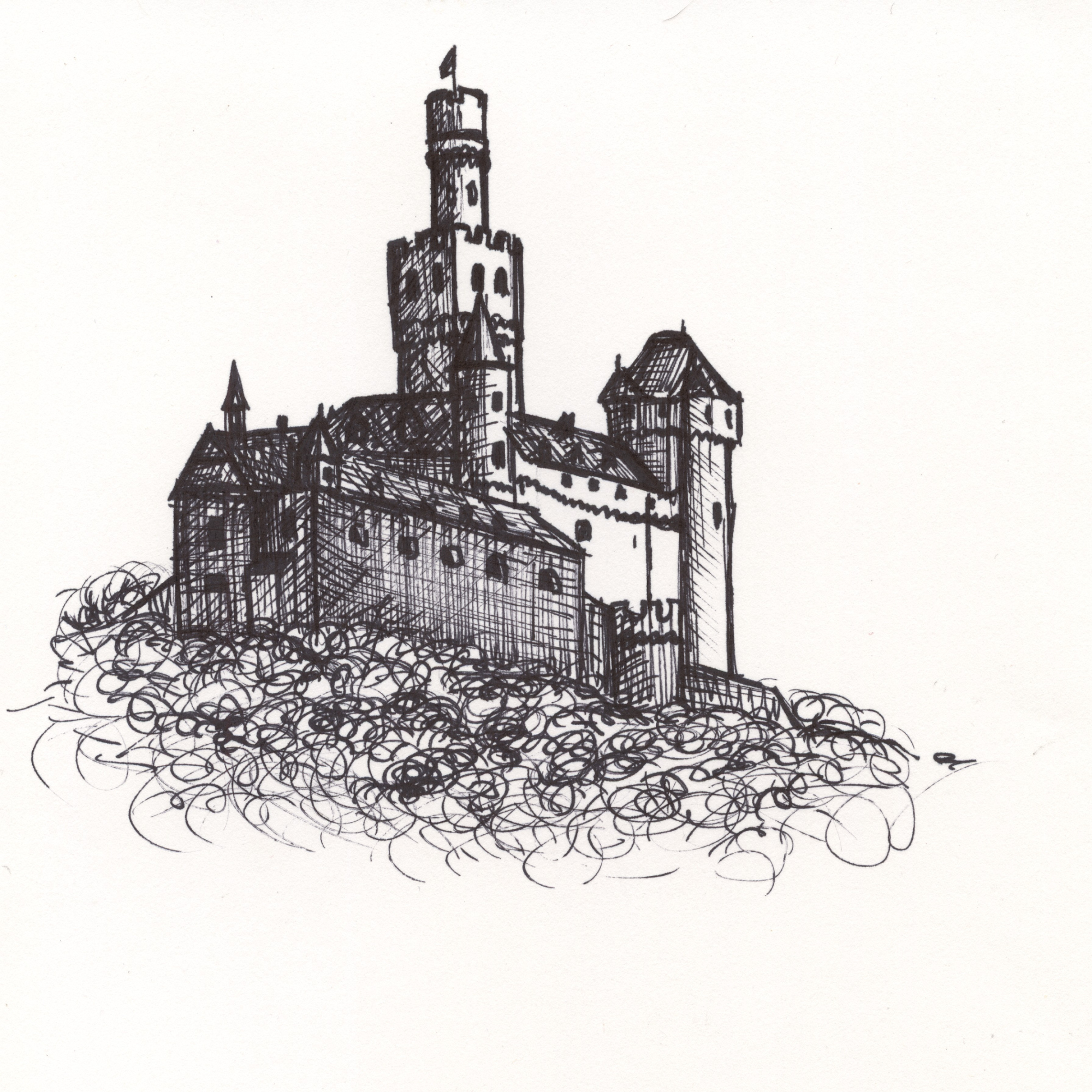
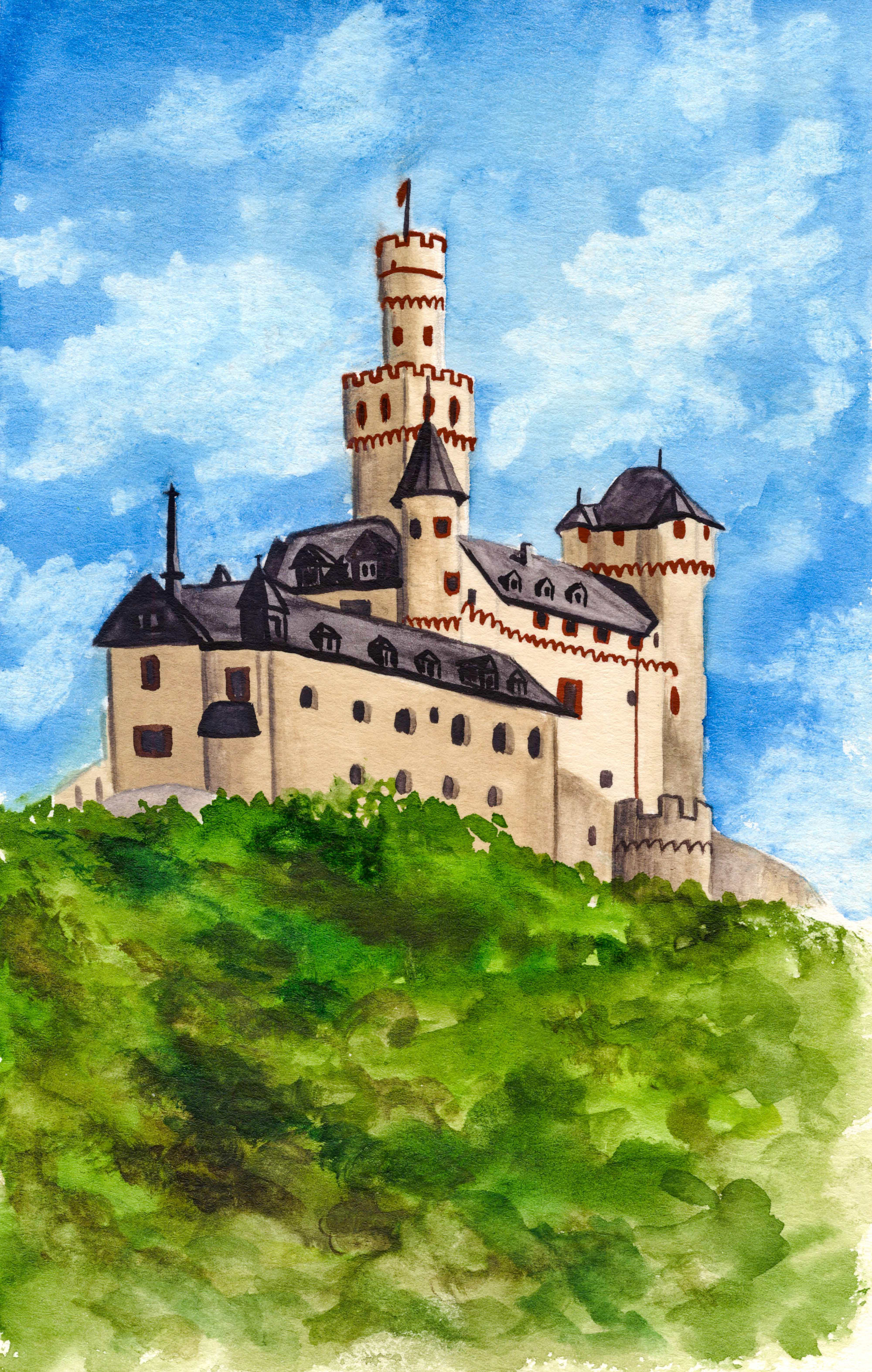 Marksburger
Marksburger
Burg Maus
Bollwerk der Grafen
Die Burg Maus, offiziell Burg Peterseck, wurde ab 1356 von den Trierer Kurfürsten errichtet. Ihre Aufgabe war die Sicherung des Rheinzolls und die Machtdemonstration gegenüber den benachbarten Grafen von Katzenelnbogen. Schlanke Türme und massive Mauern spiegeln die Prinzipien von Ordnung und territorialer Kontrolle wider. Bis heute fasziniert sie als steinernes Zeugnis mittelalterlicher Macht.
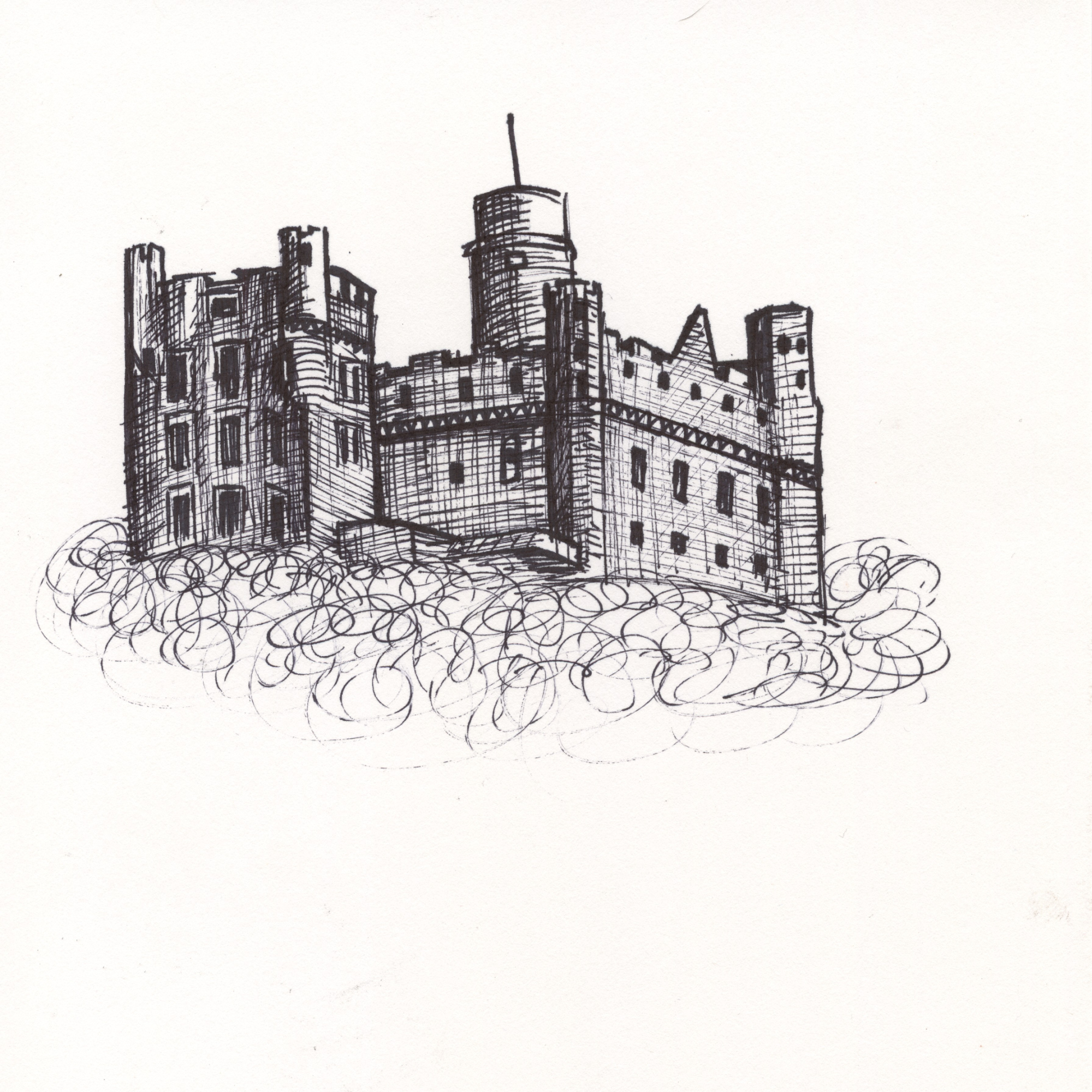
Burg Katz
Symbol strategischer Macht
Oberhalb von St. Goarshausen erhebt sich die Burg Katz, um 1371 von den Grafen von Katzenelnbogen errichtet. Ihre Aufgabe war klar: Kontrolle des Rheins und Sicherung der Zolleinnahmen. Die kompakte Bauweise und die markante Lage stehen für Einfluss und herrschaftliche Dominanz. Noch immer beeindruckt sie als Monument strategischer Weitsicht.

Schönburg
Festung der Macht und des Ansehens
Über Oberwesel thront die Schönburg, deren Ursprünge bis ins 12. Jahrhundert zurückreichen. Sie war Symbol für die mittelalterliche Ordnung: Lehnstreue, Schutz und Kontrolle der Handelswege. Mit ihren Mauern und Türmen überwachte sie den Rhein und bot Sicherheit vor Fehden und Überfällen. Ihre Geschichte erzählt von einer Zeit, in der Kontrolle und Schutz über allem standen.
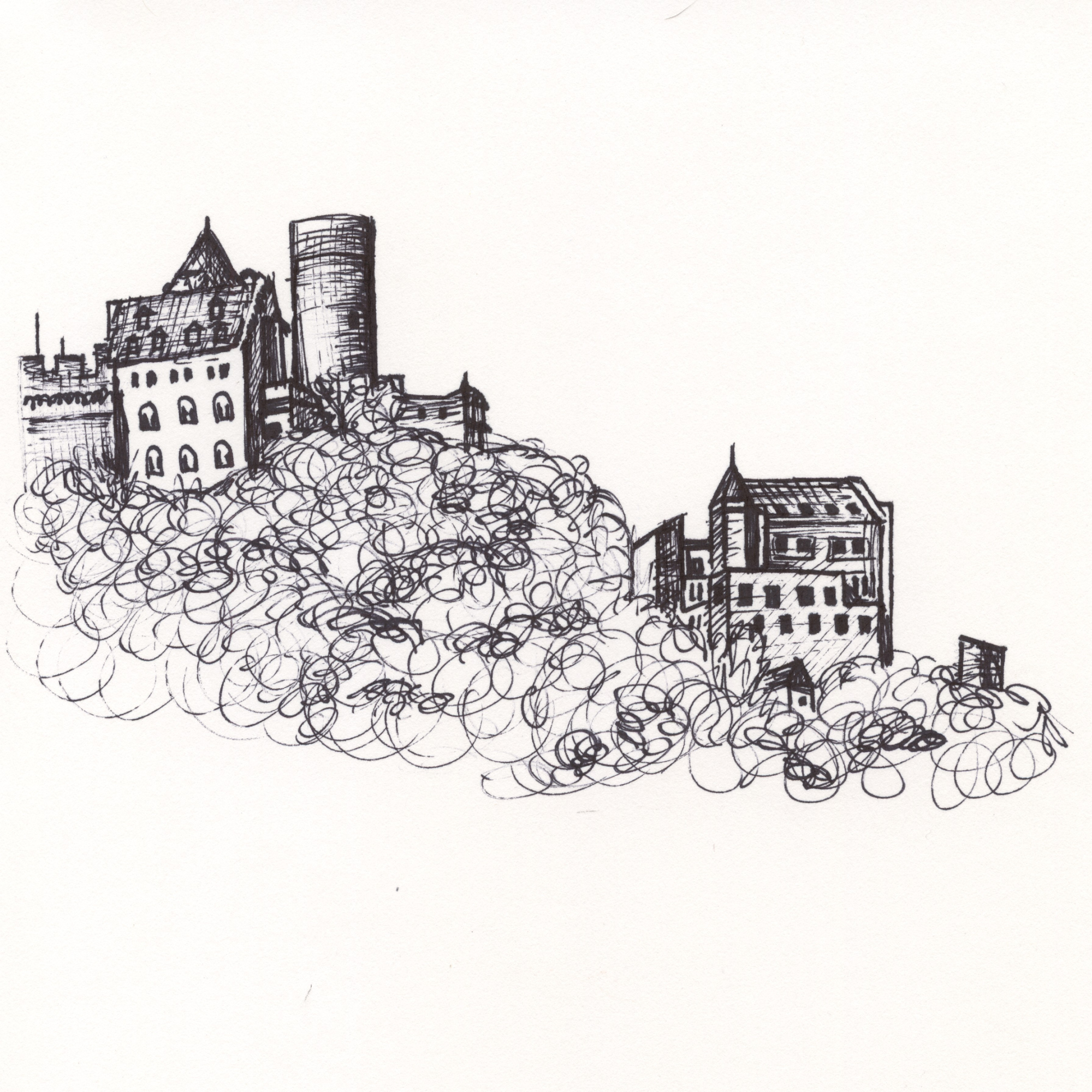
Burg Stahleck
Festung und Fürstenhof
Die Burg Stahleck bei Bacharach wurde im 12. Jahrhundert errichtet und war einst Sitz der Pfalzgrafen bei Rhein. Ihre Aufgabe: Kontrolle des Handels und Demonstration fürstlicher Macht. Die Burg vereint Schutzfunktion mit repräsentativer Architektur: ein steinernes Zeichen für Einfluss und Status. Heute beherbergt sie eine Jugendherberge, doch ihre Mauern bewahren die Aura fürstlicher Macht.

Burg Fürstenberg
Kontrollpunkt des Stroms
Hoch über dem Rhein erhebt sich die Burg Fürstenberg, errichtet um 1219 als Zoll- und Schutzburg. Ihre Mauern verkörpern die Ideale von Ordnung und Herrschaft. Strategisch platziert, kontrollierte sie den Flussverkehr und sicherte den Einfluss der Kurfürsten. Die Ruine öffnet den Blick in eine Vergangenheit, in der Besitz und Macht sichtbar gebaut wurden.
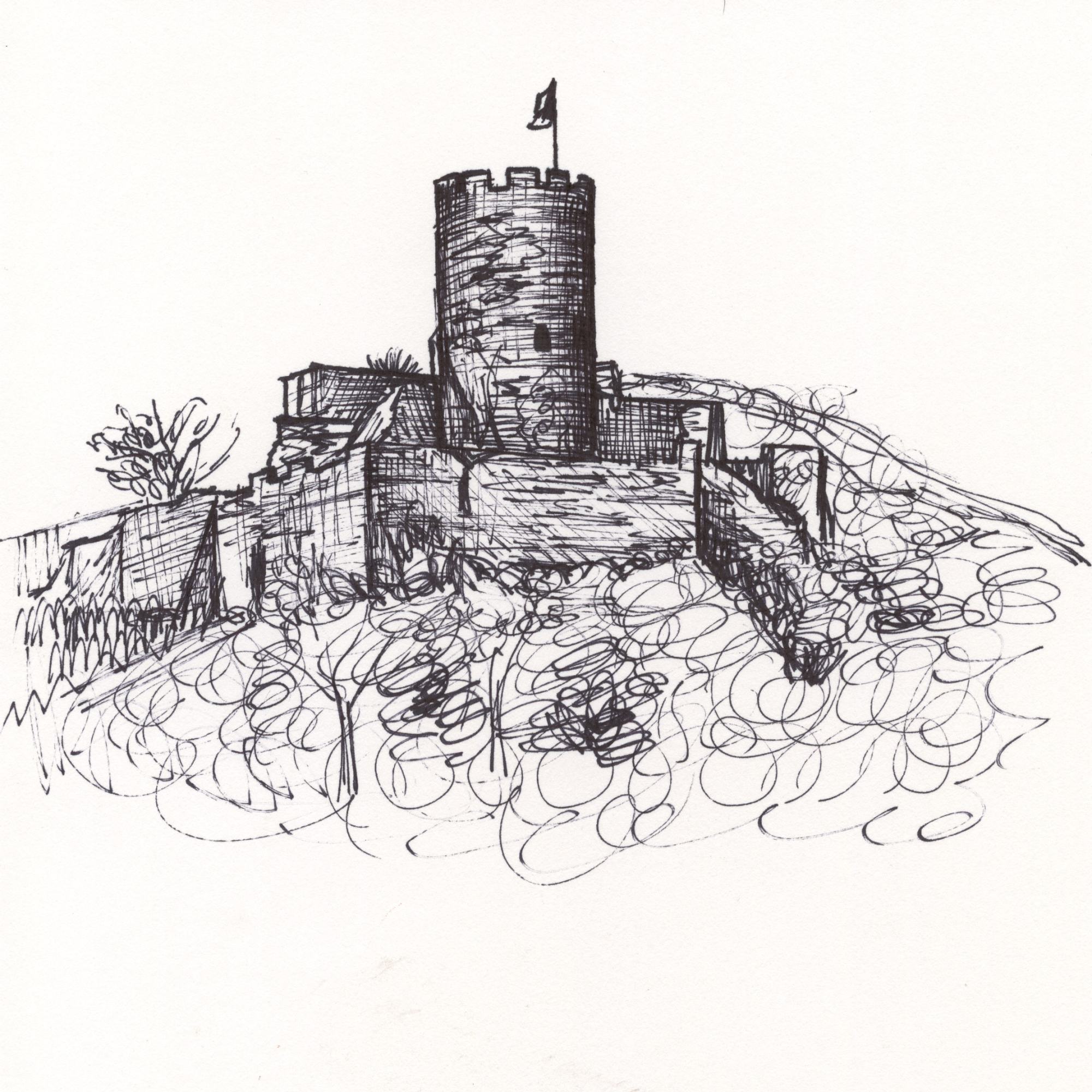
Burg Ehrenfels
Grenzposten des Rheingaus
Die Burg Ehrenfels thront oberhalb von Rüdesheim, erbaut um 1211 als Zollburg der Mainzer Erzbischöfe. Ihre Lage war ideal: Kontrolle des Rheins und Schutz der Weinbaugebiete. Die mächtigen Mauern und der dominante Bergfried zeugen von einer Epoche, in der Macht und Besitz durch Stein manifestiert wurden. Ein romantisches Relikt, das den Blick über Rhein und Weinberge eröffnet.

Mäuseturm
Legendenwacht im Rhein
Der Mäuseturm bei Bingen, ursprünglich im 13. Jahrhundert als Zollturm errichtet, steht auf einer kleinen Insel mitten im Rhein. Sein Name ist von einer düsteren Sage geprägt: Ein grausamer Bischof soll hier von Mäusen gefressen worden sein. Eine Mahnung gegen Hochmut und Tyrannei. Strategisch diente der Turm der Kontrolle des Schiffsverkehrs und der Sicherung von Einnahmen. Das markante Wahrzeichen verbindet Geschichte und Legende auf einzigartige Weise.
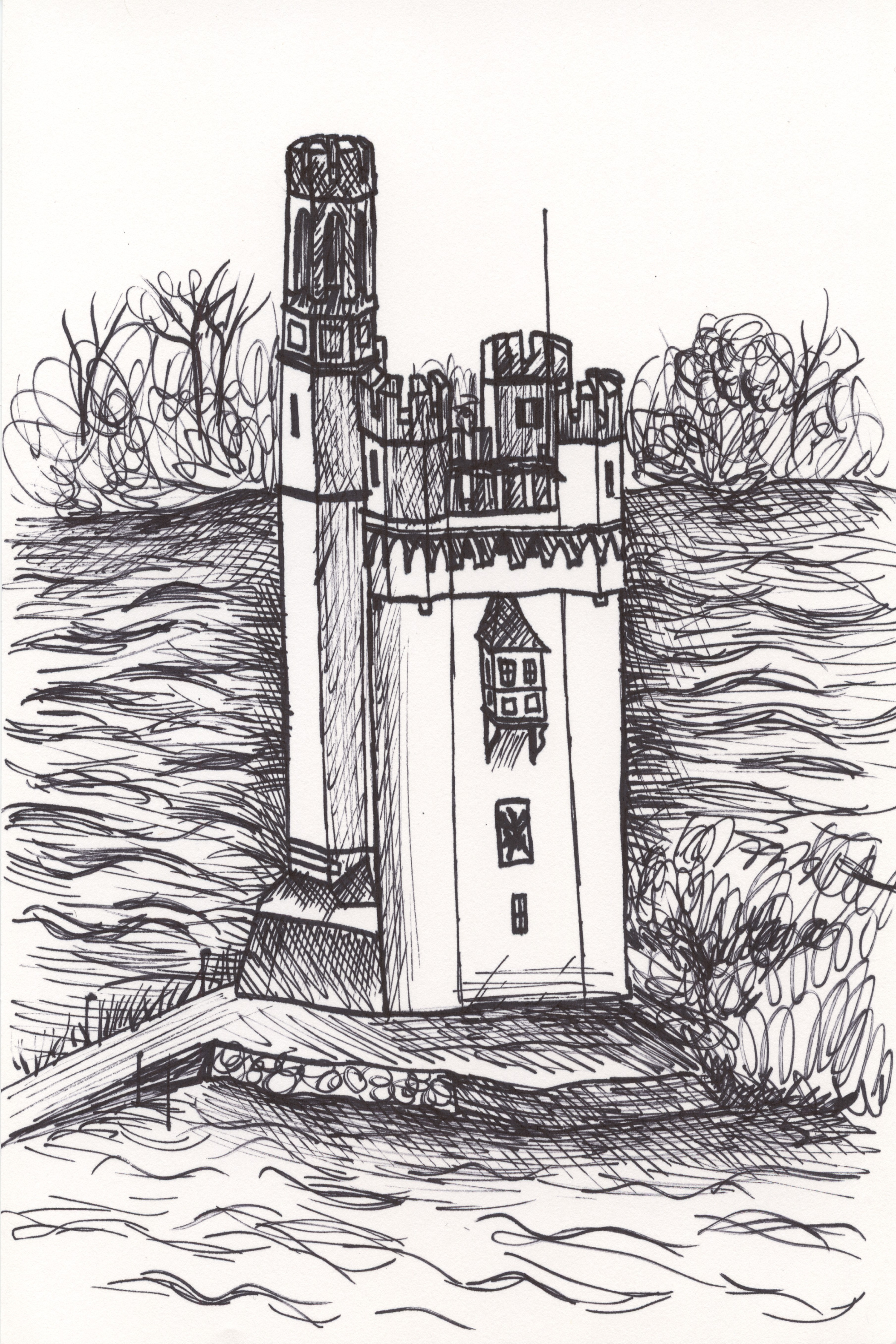
Karte: Standorte der Burgen am Mittelrhein

-
StickyMCP: Notes That Stick, Even in the Cloud
A MCP server is something an AI system can reach out to and actually do something with, unlike its usual diet of stale training data and existential boredom.
StickyMCP implements something refreshingly familiar: sticky notes. You type a short message, and it gets stored. Just like the real ones you stick on your coffee machine, desk surface, or whiteboard. Minimalism meets machine memory.
I built it during hackathon week, where ideas fly fast and only the sticky ones survive 🧷
Example: Using MCP Inspector to Display Text and Graph Output from the StickyMCP Server


🐙 GitHub Repository
Sticky code, sticky notes, find it all here:
https://github.com/jurgen178/mcp-sticky-notes
(also mirrored at https://github.com/microsoft/mcp-sticky-notes)🔧 What It Is
StickyMCP is a lightweight MCP server that lets users create, list, and delete virtual sticky notes, stored in Azure Table Storage and rendered either as plain text or classic sticky note-style PNGs. It showcases how the Model Context Protocol (MCP) can power distributed, developer-friendly microservices with visual flair.
StickyMCP provides a clean API for managing notes across systems, integrates naturally with Visual Studio Code Copilot Chat, and supports both HTTP and STDIO transports.
Each note is stored in Azure Table Storage (with in-memory fallback) and rendered as:
- Plain text (for automation and workflows)
- PNG images (for dashboards, markdown previews, or collaborative tools)
🧪 Core Features
- Add note
- List all notes
- Get note by ID
- Delete note by ID
- Delete all notes
- Group notes by logical key (e.g., personal, work, ideas)
- Render notes as PNGs
- Use in-memory fallback if Azure is unavailable
- HTTP or STDIO transport protocol
🖼️ Example Screenshots
Add a Sticky Note from a Client
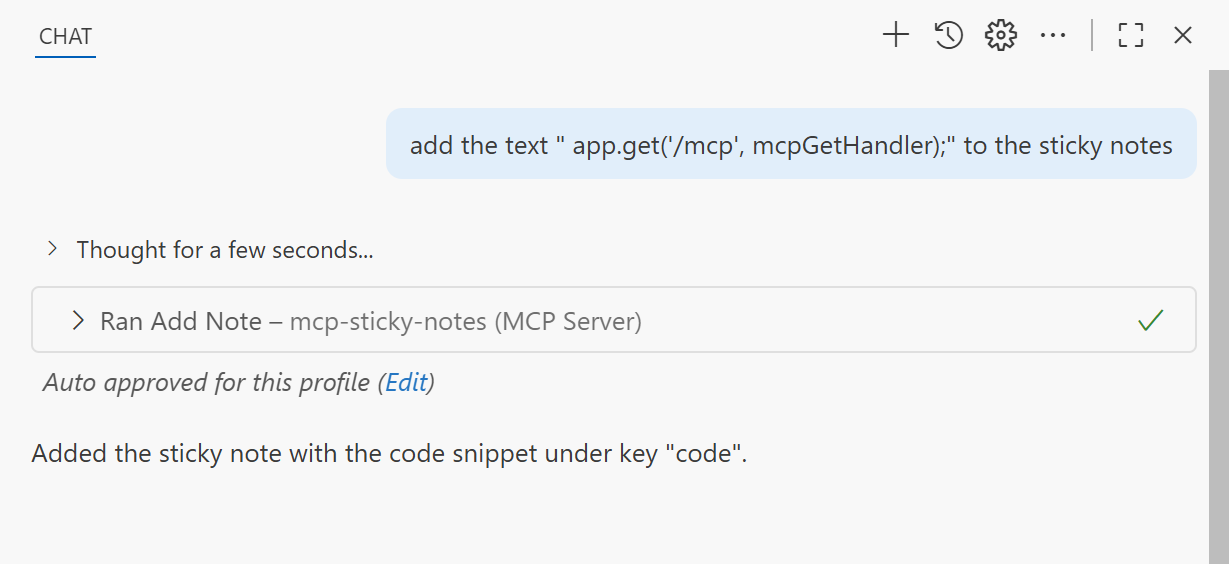
Console Logging for Adding a Sticky Note

List all Sticky Notes from a Client
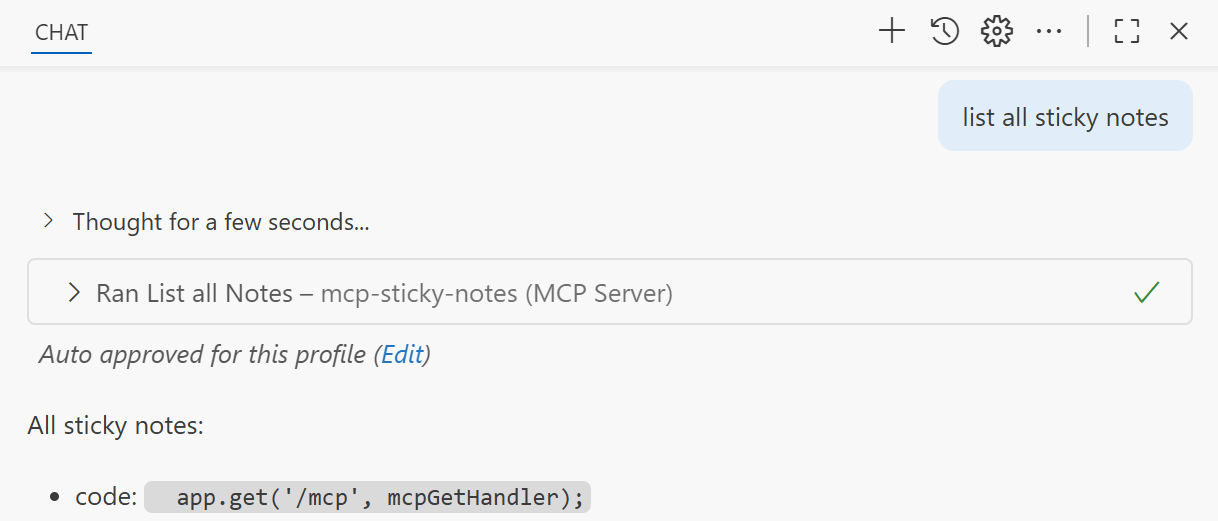
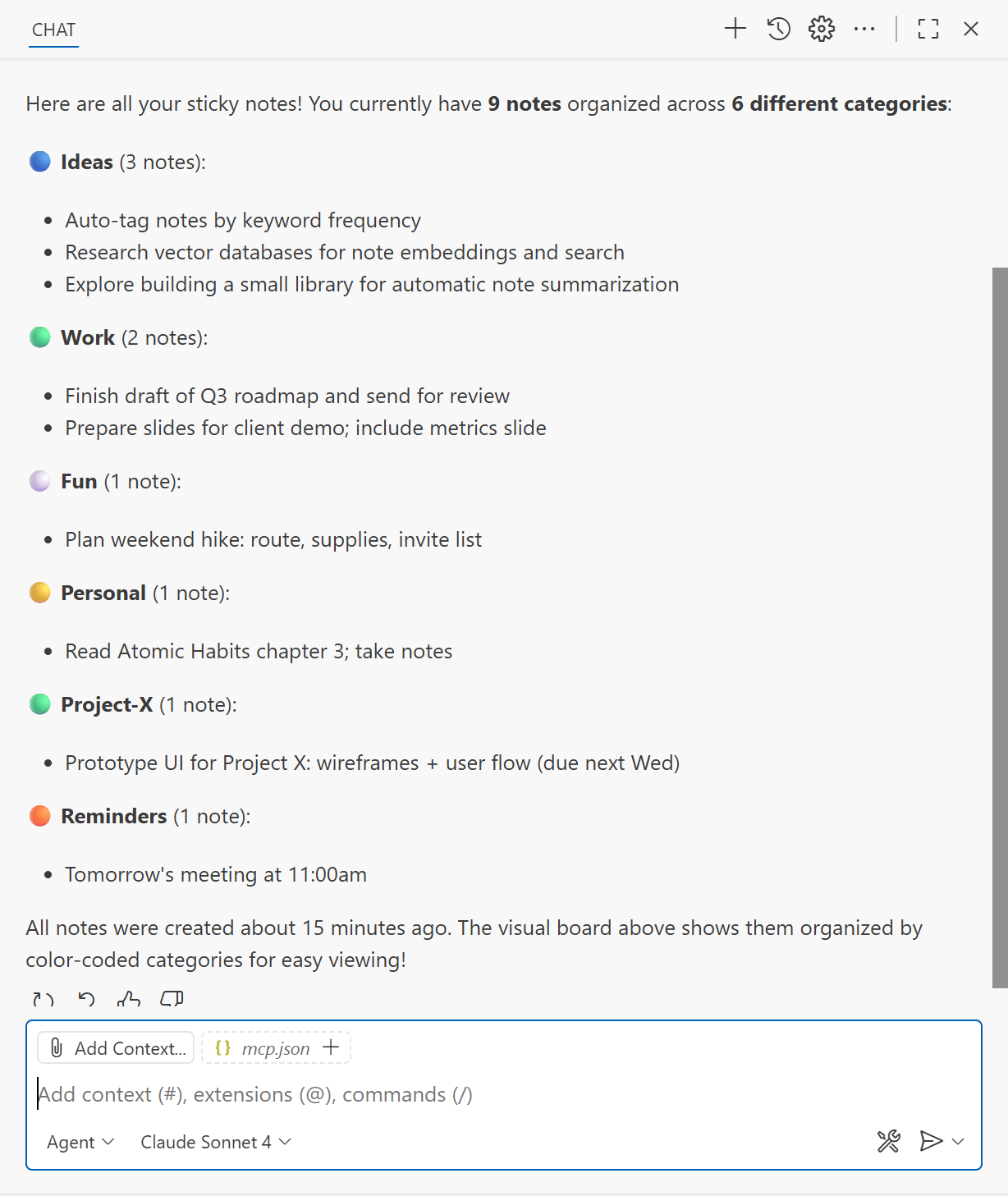
Console Logging for Listing All Sticky Notes

Short demo video showing how to add, list, and inspect sticky notes using MCP Inspector
🛠️ Tech Stack
- Server: MCP implementation in TypeScript
- Storage: Azure Table Storage (Managed Identity preferred)
- Rendering: PNG generation via node-canvas
📦 Installation
git clone https://github.com/jurgen178/mcp-sticky-notes
cd mcp-sticky-notes
npm install##### âï¸ Run on Azure Deploy server.ts as a WebApp on Azure. CoPilot can assist with setup, it is trained to handle this kind of deployment. Just ask.
##### ð» Run Locally ```npx ts-node server.ts``` Server responds on ```http://localhost:3000``` Update your mcp.json: ``` { "servers": { "mcp-sticky-notes": { "url": "http://localhost:3000/mcp?userId=demo_user" } } } ```🧭 MCP Inspector
Use the MCP Inspector to debug
npx @modelcontextprotocol/inspectorSet command to
http://localhost:3000/mcp?userId=demo_user🌐 HTTP Endpoints
POST /mcp
GET /mcp
DELETE /mcpMCP clients must initialize first to receive a mcp-session-id.
🖼️ Client Limitation for Images
Not all clients can display the generated PNG images. For example, Visual Studio Code Copilot currently does not render them. Until image support is available, visual results can be viewed using the MCP Inspector.
📍 Why It Matters
StickyMCP demonstrates how MCP can be used to build scalable, visually engaging microservices that integrate seamlessly with Azure and developer tools.
Seite 1 von 50
Ältere Beiträge →